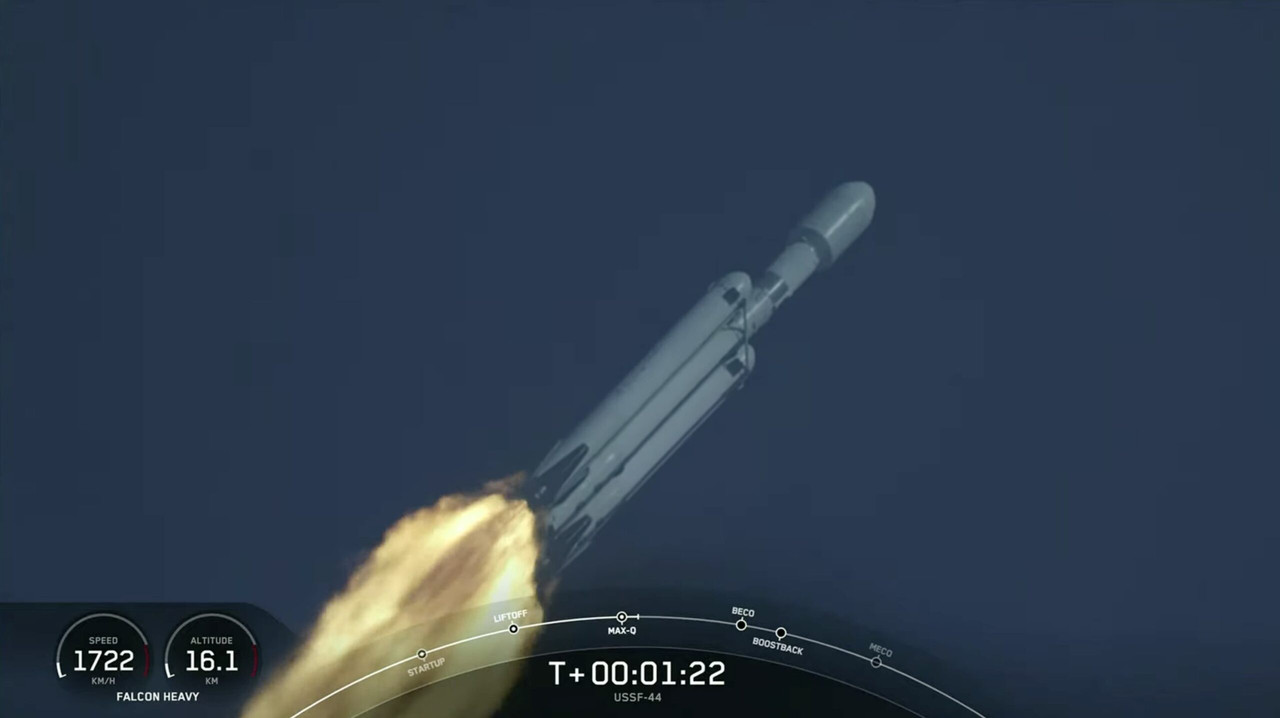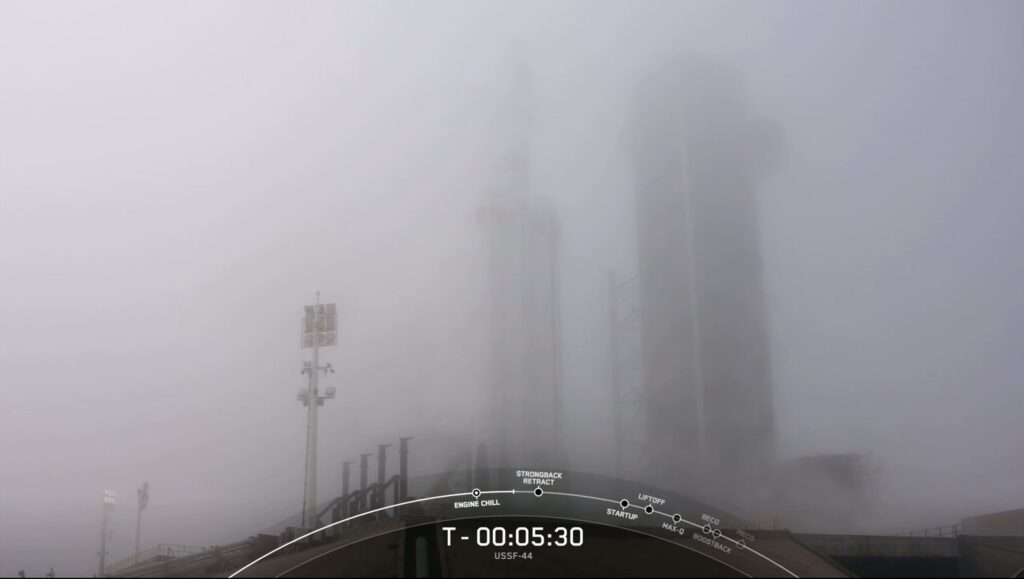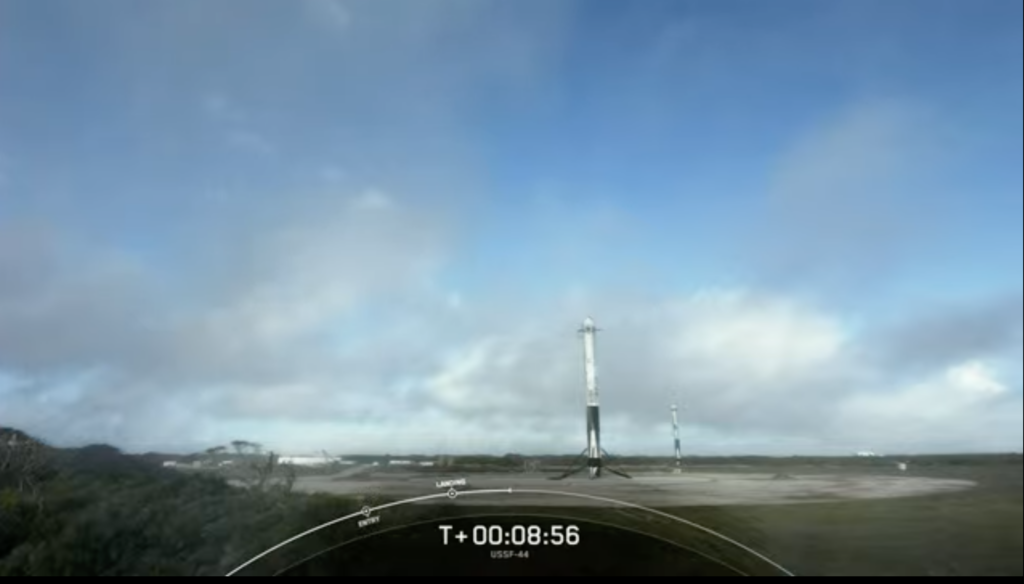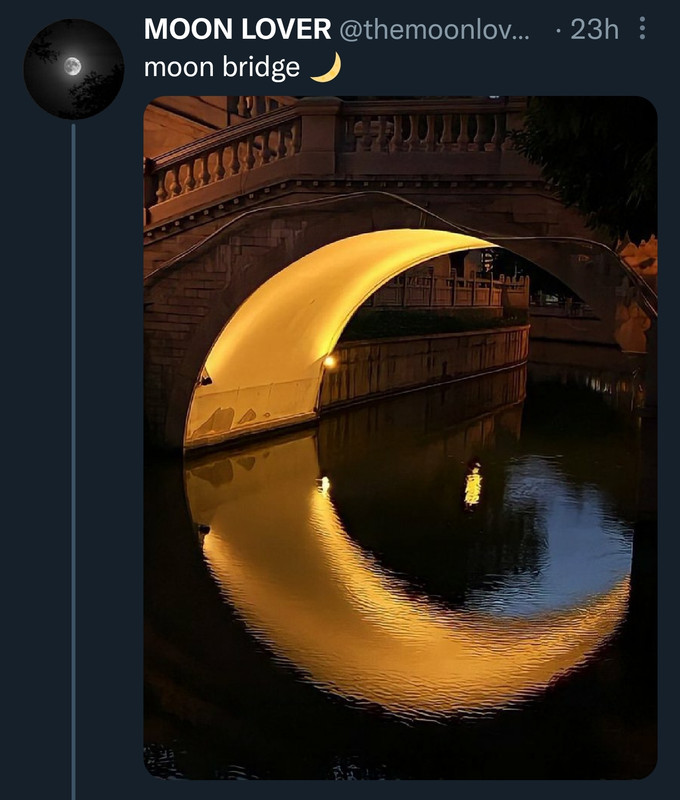-
SCAM WARNING! See how this scam works in Classifieds.
You are using an out of date browser. It may not display this or other websites correctly.
You should upgrade or use an alternative browser.
You should upgrade or use an alternative browser.
I just saw the moon
- Thread starter TheMadDabber
- Start date
CrazyDiamond
HAL is a StarChild
What mysteries might be solved by peering into this crystal ball? In this case, the ball is actually a moon of Jupiter, the crystals are ice, and the moon is not only dirty but cracked beyond repair. Nevertheless, speculation is rampant that oceans exist under Europa's fractured ice-plains that could support life. Europa, roughly the size of Earth's Moon, is pictured here in an image taken a few days ago when the Jupiter-orbiting robotic spacecraft Juno passed within 325 kilometers of its streaked and shifting surface. Underground oceans are thought likely because Europa undergoes global flexing due to its changing gravitational attraction with Jupiter during its slightly elliptical orbit, and this flexing heats the interior. Studying Juno's close-up images may further humanity's understanding not only of Europa and the early Solar System but also of the possibility that life exists elsewhere in the universe.

What could shoot out a neutron star like a cannon ball? A supernova. About 10,000 years ago, the supernova that created the nebular remnant CTB 1 not only destroyed a massive star but blasted its newly formed neutron star core -- a pulsar -- out into the Milky Way Galaxy. The pulsar, spinning 8.7 times a second, was discovered using downloadable software Einstein@Home searching through data taken by NASA's orbiting Fermi Gamma-Ray Observatory. Traveling over 1,000 kilometers per second, the pulsar PSR J0002+6216 (J0002 for short) has already left the supernova remnant CTB 1, and is even fast enough to leave our Galaxy. Pictured, the trail of the pulsar is visible extending to the lower left of the supernova remnant. The featured image is a combination of radio images from the VLA and DRAO radio observatories, as well as data archived from NASA's orbiting IRAS infrared observatory. It is well known that supernovas can act as cannons, and even that pulsars can act as cannonballs -- what is not known is how supernovas do it.

This may have been posted already, this is a very large image. The whole thing looks like an eagle. A closer look at the Eagle Nebula's center, however, shows the bright region is actually a window into the center of a larger dark shell of dust. Through this window, a brightly-lit workshop appears where a whole open cluster of stars is being formed. In this cavity tall pillars and round globules of dark dust and cold molecular gas remain where stars are still forming. Paradoxically, it is perhaps easier to appreciate this impressive factory of star formation by seeing it without its stars -- which have been digitally removed in the featured image. The Eagle emission nebula, tagged M16, lies about 6500 light years away, spans about 20 light-years, and is visible with binoculars toward the constellation of the Serpent (Serpens). Creating this picture involved over 22 hours of imaging and combining colors emitted specifically by hydrogen (red), and oxygen (blue).
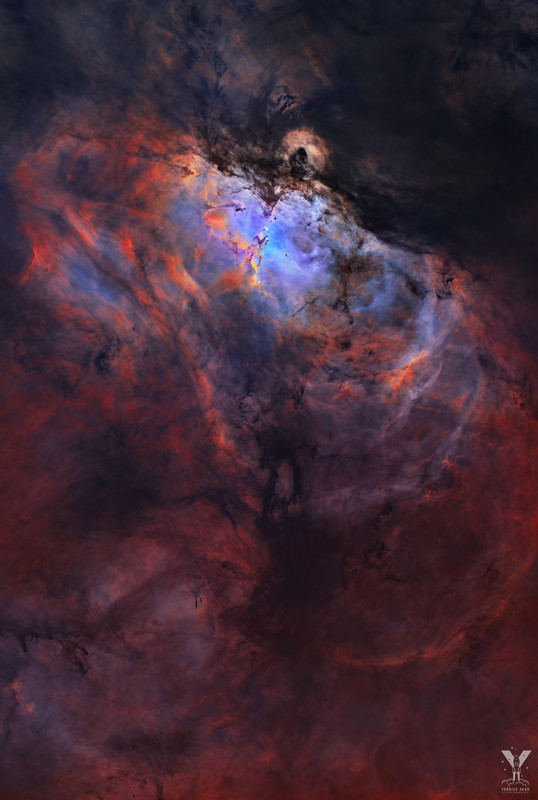
NGC 4631 is a big beautiful spiral galaxy. Seen edge-on, it lies only 25 million light-years away in the well-trained northern constellation Canes Venatici. The galaxy's slightly distorted wedge shape suggests to some a cosmic herring and to others its popular moniker, The Whale Galaxy. Either way, it is similar in size to our own Milky Way. In this sharp color image, the galaxy's yellowish core, dark dust clouds, bright blue star clusters, and red star forming regions are easy to spot. A companion galaxy, the small elliptical NGC 4627 is just above the Whale Galaxy. Faint star streams seen in deep images are the remnants of small companion galaxies disrupted by repeated encounters with the Whale in the distant past. The Whale Galaxy is also known to have spouted a halo of hot gas glowing in X-rays.
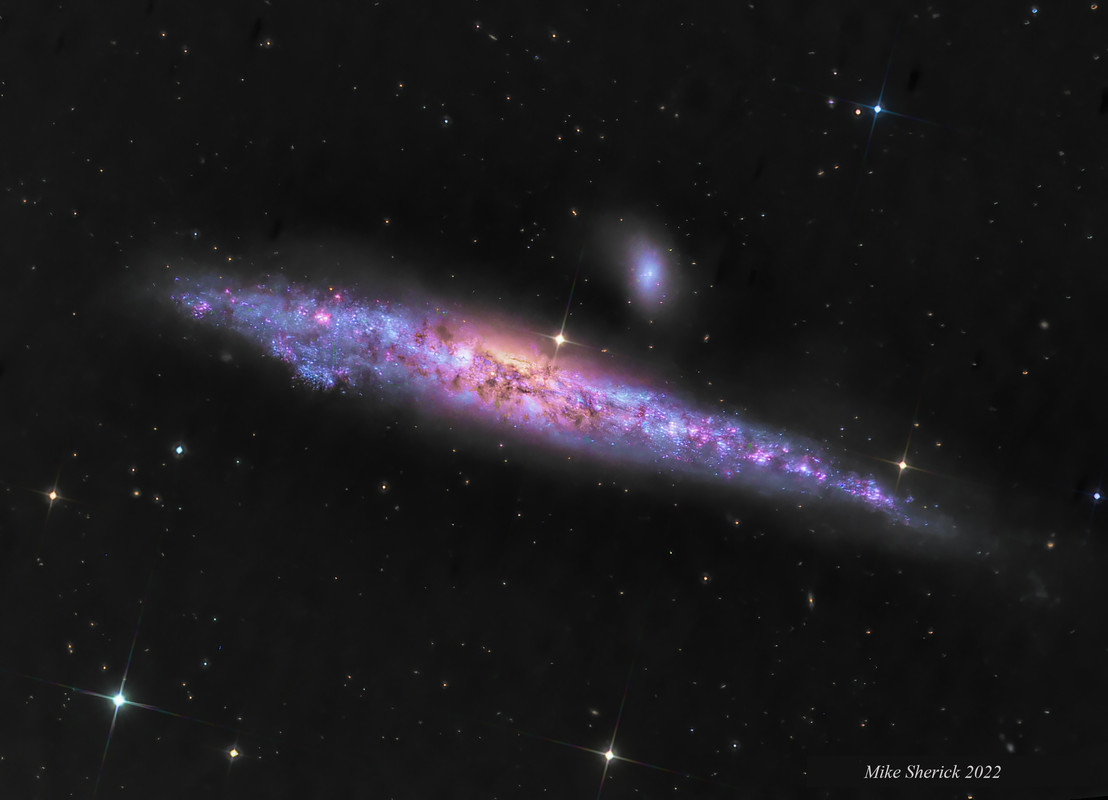
What dark structures arise within the Pelican Nebula? On the whole, the nebula appears like a bird (a pelican) and is seen toward the constellation of a different bird: Cygnus, a Swan. But inside, the Pelican Nebula is a place lit up by new stars and befouled by dark dust. Smoke-sized dust grains start as simple carbon compounds formed in the cool atmospheres of young stars but are dispersed by stellar winds and explosions. Two impressive Herbig-Haro jets are seen emitted by the star HH 555 on the right, and these jets are helping to destroy the light year-long dust pillar that contains it. Other pillars and jets are also visible. The featured image was scientifically-colored to emphasize light emitted by small amounts of heavy elements in a nebula made predominantly of the light elements hydrogen and helium. The Pelican Nebula (IC 5067 and IC 5070) is about 2,000 light-years away and can be found with a small telescope to the northeast of the bright star Deneb.
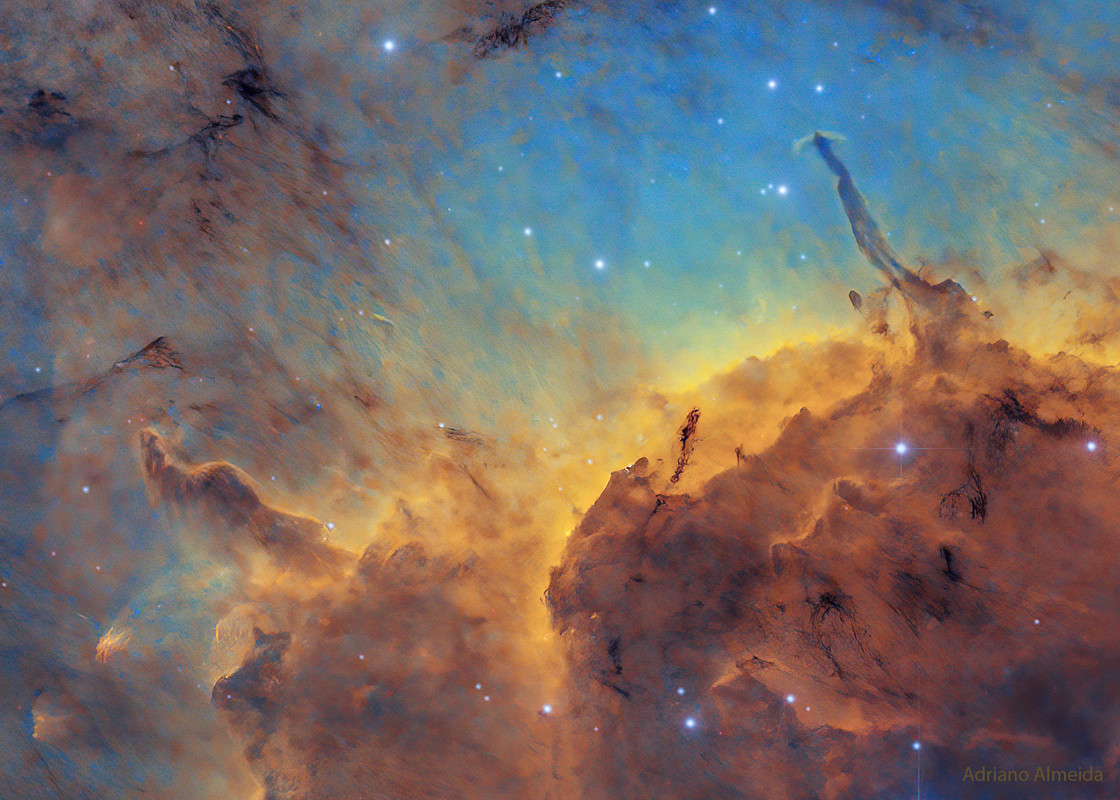
A mysterious squid-like cosmic cloud, this nebula is very faint, but also very large in planet Earth's sky. In the image, composed with 30 hours of narrowband image data, it spans nearly three full moons toward the royal constellation Cepheus. Discovered in 2011 by French astro-imager Nicolas Outters, the Squid Nebula's bipolar shape is distinguished here by the telltale blue-green emission from doubly ionized oxygen atoms. Though apparently surrounded by the reddish hydrogen emission region Sh2-129, the true distance and nature of the Squid Nebula have been difficult to determine. Still, a more recent investigation suggests Ou4 really does lie within Sh2-129 some 2,300 light-years away. Consistent with that scenario, the cosmic squid would represent a spectacular outflow of material driven by a triple system of hot, massive stars, cataloged as HR8119, seen near the center of the nebula. If so, this truly giant squid nebula would physically be over 50 light-years across.
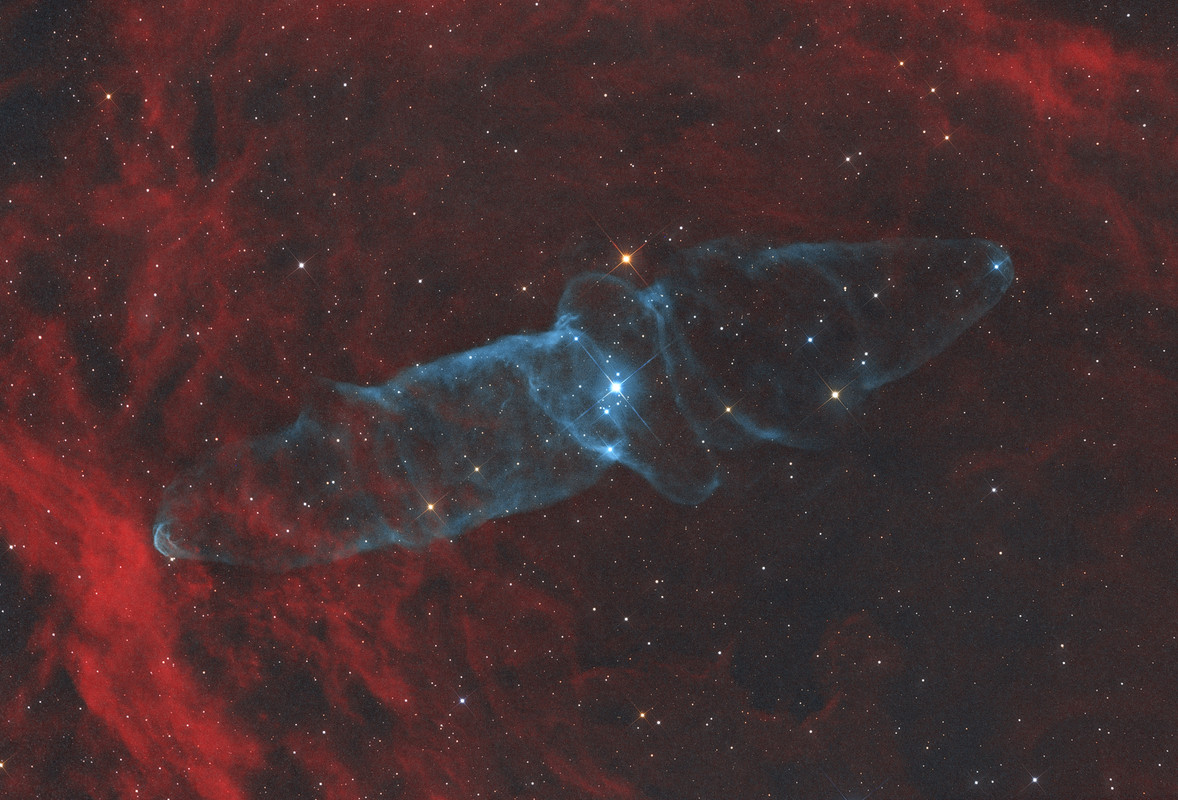
Across the center of this spiral galaxy is a bar. And at the center of this bar is smaller spiral. And at the center of that spiral is a supermassive black hole. This all happens in the big, beautiful, barred spiral galaxy cataloged as NGC 1300, a galaxy that lies some 70 million light-years away toward the constellation of the river Eridanus. This Hubble Space Telescope composite view of the gorgeous island universe is one of the most detailed Hubble images ever made of a complete galaxy. NGC 1300 spans over 100,000 light-years and the Hubble image reveals striking details of the galaxy's dominant central bar and majestic spiral arms. How the giant bar formed, how it remains, and how it affects star formation remains an active topic of research.

The dark clouds in this image, taken from ESO’s Paranal Observatory in Chile, almost resemble something supernatural, like the wispy trails of ghosts in the sky. But there is no need to call the ghostbusters! These clouds, known as Barnard 92 (right) and Barnard 93 (left) are dark nebulae: they look pitch black because the dense gas and dust they contain block out the background light, creating these hazy ghostlike features.
These nebulae are stellar nurseries, where new stars are born out of the collapsing dense gas and dust. This whole region of space imaged here is actually part of a much larger stellar complex, called the Small Sagittarius Star Cloud (or Messier 24, catalogued by Charles Messier in 1764). This area is so rich in stars that it is clearly visible to the naked eye during dark nights, in the constellation of Sagittarius.
This image was taken with an enormous 268 million pixel camera called OmegaCAM on the VLT Survey Telescope. OmegaCAM is designed for capturing wide fields like this image, where you could impressively fit four full Moons. This image is part of the VST Photometric Hα Survey of the Southern Galactic Plane and Bulge (VPHAS+), which has mapped diffuse nebulae as well as both young and evolved stars in our galaxy.
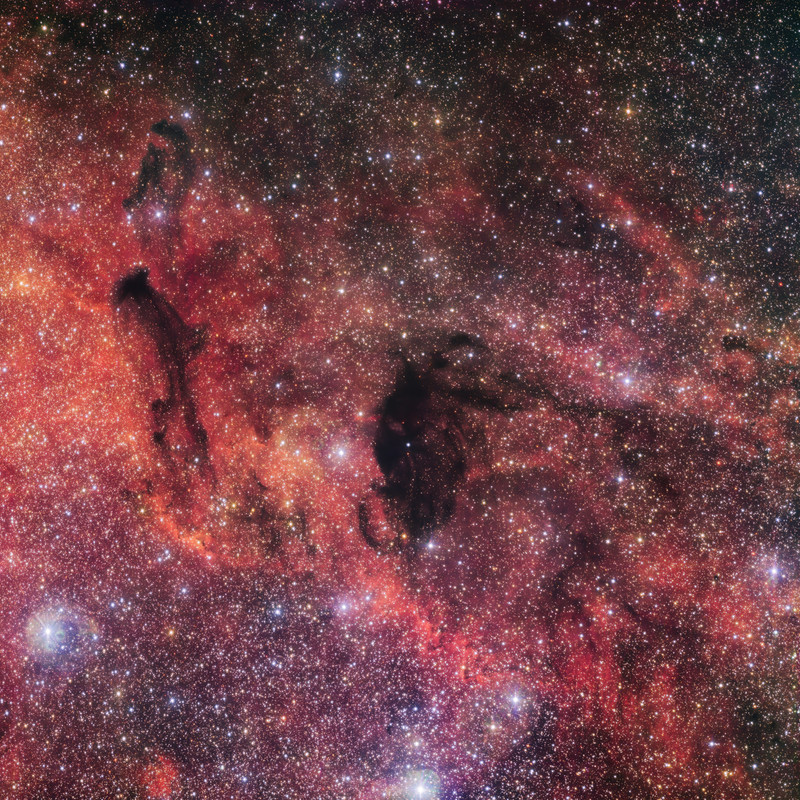

What could shoot out a neutron star like a cannon ball? A supernova. About 10,000 years ago, the supernova that created the nebular remnant CTB 1 not only destroyed a massive star but blasted its newly formed neutron star core -- a pulsar -- out into the Milky Way Galaxy. The pulsar, spinning 8.7 times a second, was discovered using downloadable software Einstein@Home searching through data taken by NASA's orbiting Fermi Gamma-Ray Observatory. Traveling over 1,000 kilometers per second, the pulsar PSR J0002+6216 (J0002 for short) has already left the supernova remnant CTB 1, and is even fast enough to leave our Galaxy. Pictured, the trail of the pulsar is visible extending to the lower left of the supernova remnant. The featured image is a combination of radio images from the VLA and DRAO radio observatories, as well as data archived from NASA's orbiting IRAS infrared observatory. It is well known that supernovas can act as cannons, and even that pulsars can act as cannonballs -- what is not known is how supernovas do it.

This may have been posted already, this is a very large image. The whole thing looks like an eagle. A closer look at the Eagle Nebula's center, however, shows the bright region is actually a window into the center of a larger dark shell of dust. Through this window, a brightly-lit workshop appears where a whole open cluster of stars is being formed. In this cavity tall pillars and round globules of dark dust and cold molecular gas remain where stars are still forming. Paradoxically, it is perhaps easier to appreciate this impressive factory of star formation by seeing it without its stars -- which have been digitally removed in the featured image. The Eagle emission nebula, tagged M16, lies about 6500 light years away, spans about 20 light-years, and is visible with binoculars toward the constellation of the Serpent (Serpens). Creating this picture involved over 22 hours of imaging and combining colors emitted specifically by hydrogen (red), and oxygen (blue).

NGC 4631 is a big beautiful spiral galaxy. Seen edge-on, it lies only 25 million light-years away in the well-trained northern constellation Canes Venatici. The galaxy's slightly distorted wedge shape suggests to some a cosmic herring and to others its popular moniker, The Whale Galaxy. Either way, it is similar in size to our own Milky Way. In this sharp color image, the galaxy's yellowish core, dark dust clouds, bright blue star clusters, and red star forming regions are easy to spot. A companion galaxy, the small elliptical NGC 4627 is just above the Whale Galaxy. Faint star streams seen in deep images are the remnants of small companion galaxies disrupted by repeated encounters with the Whale in the distant past. The Whale Galaxy is also known to have spouted a halo of hot gas glowing in X-rays.

What dark structures arise within the Pelican Nebula? On the whole, the nebula appears like a bird (a pelican) and is seen toward the constellation of a different bird: Cygnus, a Swan. But inside, the Pelican Nebula is a place lit up by new stars and befouled by dark dust. Smoke-sized dust grains start as simple carbon compounds formed in the cool atmospheres of young stars but are dispersed by stellar winds and explosions. Two impressive Herbig-Haro jets are seen emitted by the star HH 555 on the right, and these jets are helping to destroy the light year-long dust pillar that contains it. Other pillars and jets are also visible. The featured image was scientifically-colored to emphasize light emitted by small amounts of heavy elements in a nebula made predominantly of the light elements hydrogen and helium. The Pelican Nebula (IC 5067 and IC 5070) is about 2,000 light-years away and can be found with a small telescope to the northeast of the bright star Deneb.

A mysterious squid-like cosmic cloud, this nebula is very faint, but also very large in planet Earth's sky. In the image, composed with 30 hours of narrowband image data, it spans nearly three full moons toward the royal constellation Cepheus. Discovered in 2011 by French astro-imager Nicolas Outters, the Squid Nebula's bipolar shape is distinguished here by the telltale blue-green emission from doubly ionized oxygen atoms. Though apparently surrounded by the reddish hydrogen emission region Sh2-129, the true distance and nature of the Squid Nebula have been difficult to determine. Still, a more recent investigation suggests Ou4 really does lie within Sh2-129 some 2,300 light-years away. Consistent with that scenario, the cosmic squid would represent a spectacular outflow of material driven by a triple system of hot, massive stars, cataloged as HR8119, seen near the center of the nebula. If so, this truly giant squid nebula would physically be over 50 light-years across.

Across the center of this spiral galaxy is a bar. And at the center of this bar is smaller spiral. And at the center of that spiral is a supermassive black hole. This all happens in the big, beautiful, barred spiral galaxy cataloged as NGC 1300, a galaxy that lies some 70 million light-years away toward the constellation of the river Eridanus. This Hubble Space Telescope composite view of the gorgeous island universe is one of the most detailed Hubble images ever made of a complete galaxy. NGC 1300 spans over 100,000 light-years and the Hubble image reveals striking details of the galaxy's dominant central bar and majestic spiral arms. How the giant bar formed, how it remains, and how it affects star formation remains an active topic of research.

The dark clouds in this image, taken from ESO’s Paranal Observatory in Chile, almost resemble something supernatural, like the wispy trails of ghosts in the sky. But there is no need to call the ghostbusters! These clouds, known as Barnard 92 (right) and Barnard 93 (left) are dark nebulae: they look pitch black because the dense gas and dust they contain block out the background light, creating these hazy ghostlike features.
These nebulae are stellar nurseries, where new stars are born out of the collapsing dense gas and dust. This whole region of space imaged here is actually part of a much larger stellar complex, called the Small Sagittarius Star Cloud (or Messier 24, catalogued by Charles Messier in 1764). This area is so rich in stars that it is clearly visible to the naked eye during dark nights, in the constellation of Sagittarius.
This image was taken with an enormous 268 million pixel camera called OmegaCAM on the VLT Survey Telescope. OmegaCAM is designed for capturing wide fields like this image, where you could impressively fit four full Moons. This image is part of the VST Photometric Hα Survey of the Southern Galactic Plane and Bulge (VPHAS+), which has mapped diffuse nebulae as well as both young and evolved stars in our galaxy.

CrazyDiamond
HAL is a StarChild
NASA’s James Webb Space Telescope has captured a lush, highly detailed landscape – the iconic Pillars of Creation – where new stars are forming within dense clouds of gas and dust. The three-dimensional pillars look like majestic rock formations, but are far more permeable. These columns are made up of cool interstellar gas and dust that appear – at times – semi-transparent in near-infrared light.
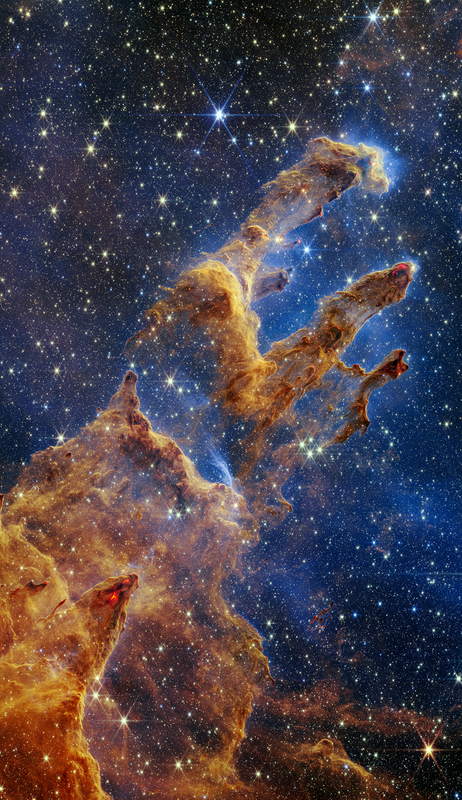
Hubble image from 1995 on the left, JWST on the right.
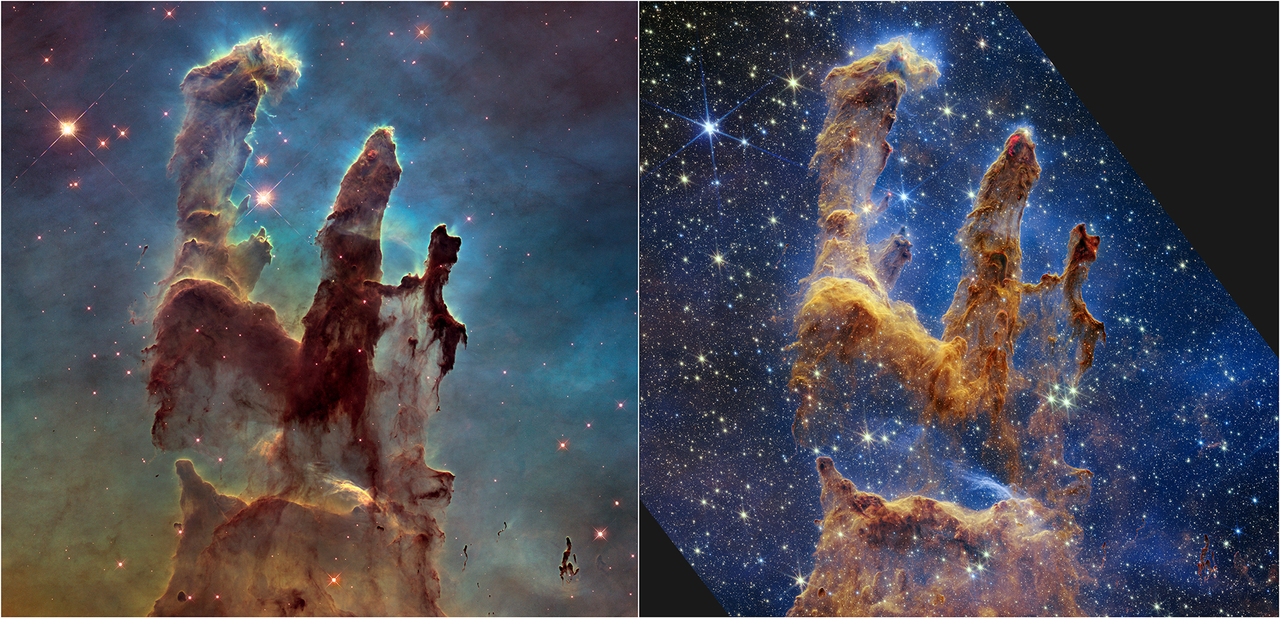

Hubble image from 1995 on the left, JWST on the right.

CrazyDiamond
HAL is a StarChild
What are those red clouds surrounding the Andromeda galaxy? This galaxy, M31, is often imaged by planet Earth-based astronomers. As the nearest large spiral galaxy, it is a familiar sight with dark dust lanes, bright yellowish core, and spiral arms traced by clouds of bright blue stars. A mosaic of well-exposed broad and narrow-band image data, this deep portrait of our neighboring island universe offers strikingly unfamiliar features though, faint reddish clouds of glowing ionized hydrogen gas in the same wide field of view. Most of the ionized hydrogen clouds surely lie in the foreground of the scene, well within our Milky Way Galaxy. They are likely associated with the pervasive, dusty interstellar cirrus clouds scattered hundreds of light-years above our own galactic plane. Some of the clouds, however, occur right in the Andromeda galaxy itself, and some in M110, the small galaxy just below.

Drifting through the Orion Arm of the spiral Milky Way Galaxy, this cosmic cloud by chance echoes the outline of California on the west coast of the United States. Our own Sun also lies within the Milky Way's Orion Arm, only about 1,500 light-years from the California Nebula. Also known as NGC 1499, the classic emission nebula is around 100 light-years long. The California Nebula shines with the telltale reddish glow characteristic of hydrogen atoms recombining with long lost electrons. The electrons have been stripped away, ionized by energetic starlight. Most likely providing the energetic starlight that ionizes much of the nebular gas is the bright, hot star Xi Persei just to the right of the nebula. A popular target for astrophotographers, this deep image reveals the glowing nebula, obscuring dust, and stars across a 3 degree wide field of view. The California nebula lies toward the constellation Perseus, not far from the Pleiades.
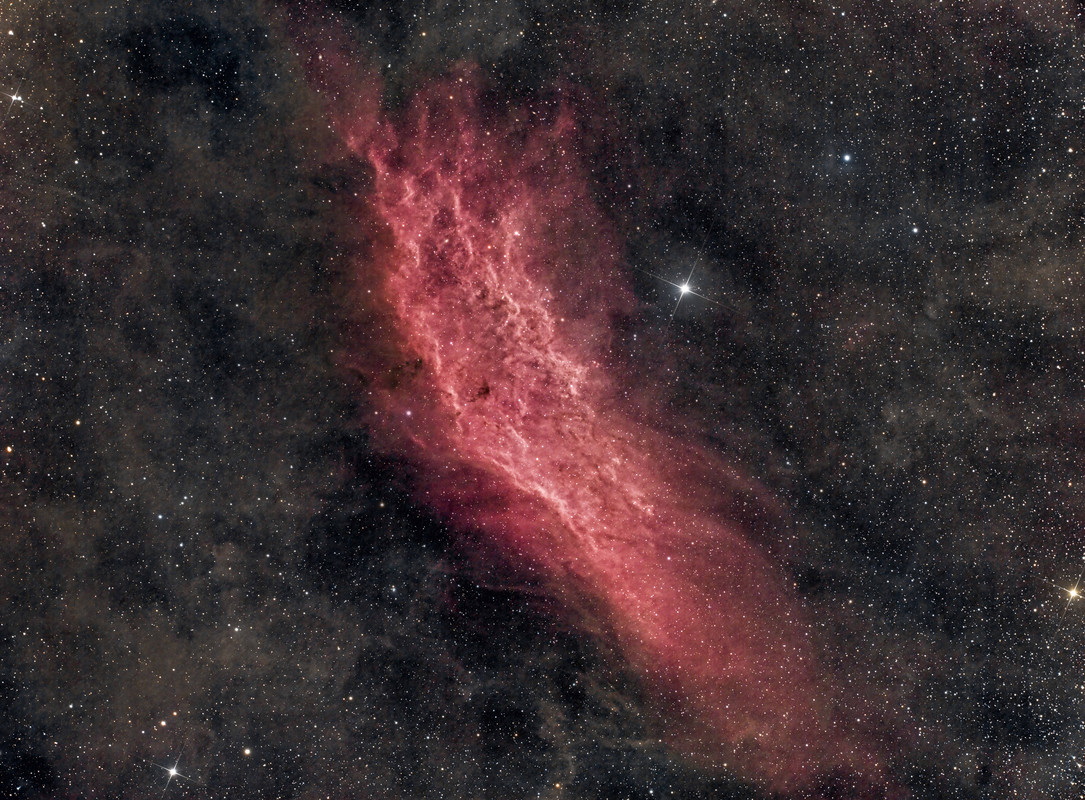
Do we dare believe our eyes? When we look at images of space, we often wonder whether they are "real", and just as often the best answer varies. In this case, the scene appears much as our eyes would see it, because it was obtained using RGB (Red, Green, Blue) filters like the cone cells in our eyes, except collecting light for 19 hours, not a fraction of a second. The featured image was captured over six nights, using a 24-inch diameter telescope in the Sierra Nevada Mountains, in California, USA. The bright spiral galaxy at the center (NGC 7497) looks like it is being grasped by an eerie tendril of a space ghost, and therein lies the trick. The galaxy is actually 59 million light years away, while the nebulosity is MBM 54, less than one thousand light years away, making it one of the nearest cool clouds of gas and dust -- galactic cirrus -- within our own Milky Way Galaxy. Both are in the constellation of Pegasus, which can be seen high overhead from northern latitudes in the autumn.
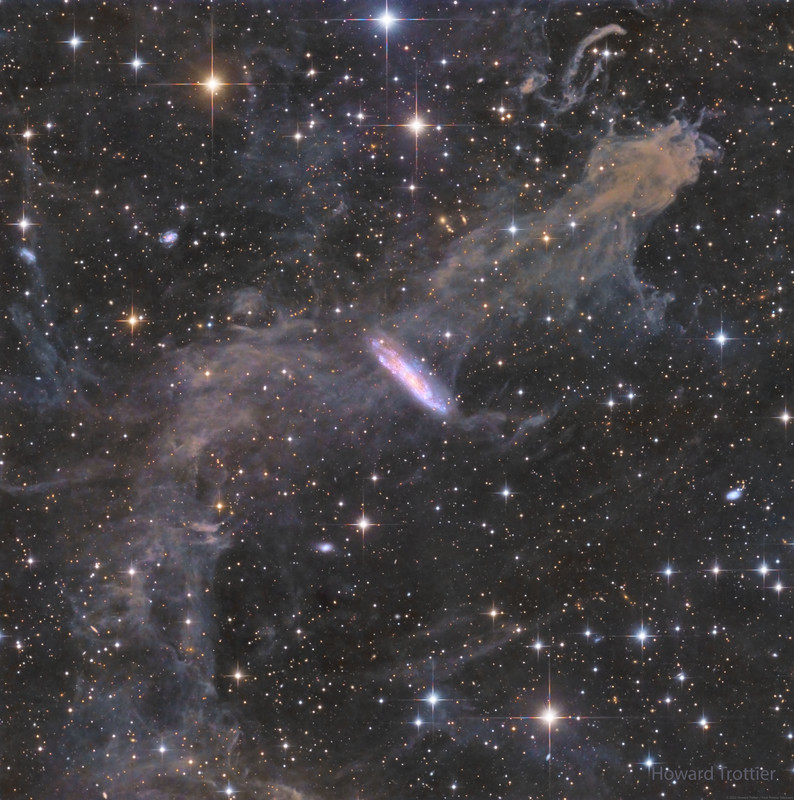
During its 40th close pass by Jupiter, our Juno spacecraft saw Ganymede cast a large, dark spot on the planet on Feb. 25, 2022.
JunoCam captured this image from very close to Jupiter, making Ganymede’s shadow appear especially large. At the time the raw image was taken, the Juno spacecraft was about 44,000 miles (71,000 kilometers) above Jupiter’s cloud tops and 15 times closer to the planet than Ganymede.

When a massive star collapsed in the Cassiopeia constellation, it generated a supernova explosion with some of the fastest shockwaves in the Milky Way. These speedy shock waves are one of the reasons the Cassiopeia A (Cas A) supernova remnant was chosen to be our Imaging X-ray Polarimetry Explorer’s (IXPE) first observed object.
This composite image, made of data from IXPE, the Chandra Observatory, and the Hubble Telescope, shows Cas A. IXPE’s investigation of Cas A from Jan. 11 to Jan. 29, 2022, added crucial information about the behavior of exploded stars’ magnetic fields: scientists found that the magnetic fields in X-rays tend to be aligned in radial, not perpendicular, directions. Polarization data also suggest that these X-rays come from turbulent regions with many different magnetic field directions.

The two interacting galaxies making up the pair known as Arp-Madore 608-333 seem to float side by side in this image from the NASA/ESA Hubble Space Telescope. Though they appear serene and unperturbed, the two are subtly warping one another through a mutual gravitational interaction that is disrupting and distorting both galaxies. Hubble’s Advanced Camera for Surveys captured this drawn-out galactic interaction.
The interacting galaxies in Arp-Madore 608-333 are part of an effort to build up an archive of interesting targets for more detailed future study with Hubble, ground-based telescopes, and the NASA/ESA/CSA James Webb Space Telescope. To build up this archive, astronomers scoured existing astronomical catalogues for a list of targets spread throughout the night sky. They hoped to include objects already identified as interesting and that would be easy for Hubble to observe no matter which direction it was pointing.
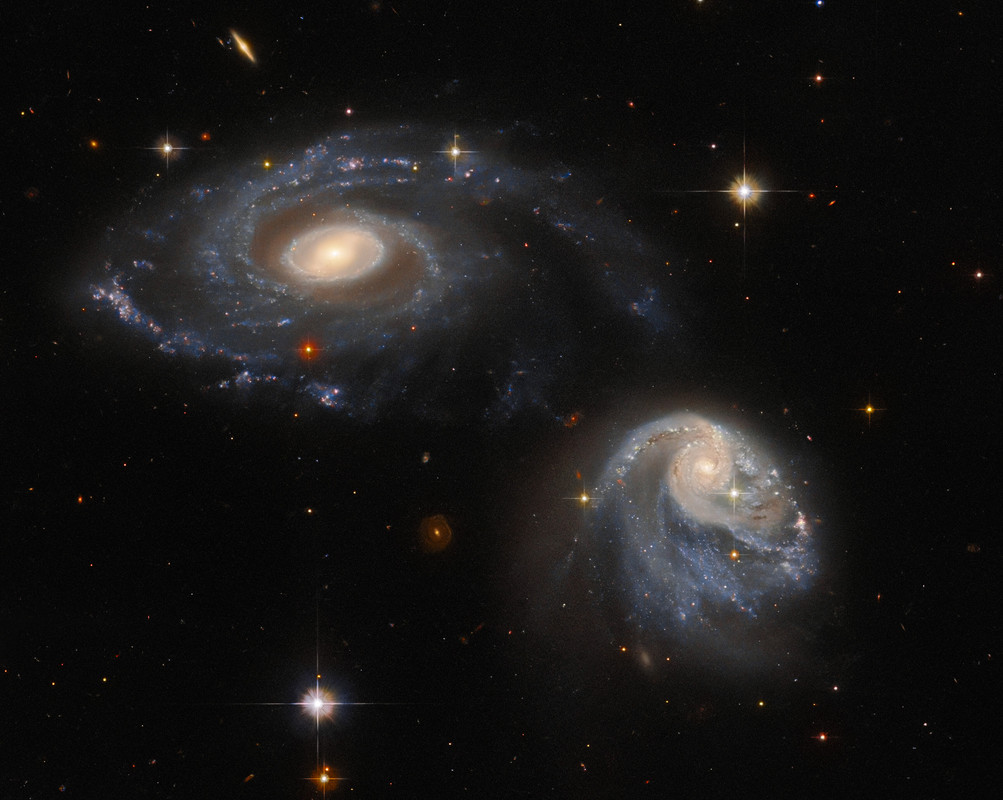

Drifting through the Orion Arm of the spiral Milky Way Galaxy, this cosmic cloud by chance echoes the outline of California on the west coast of the United States. Our own Sun also lies within the Milky Way's Orion Arm, only about 1,500 light-years from the California Nebula. Also known as NGC 1499, the classic emission nebula is around 100 light-years long. The California Nebula shines with the telltale reddish glow characteristic of hydrogen atoms recombining with long lost electrons. The electrons have been stripped away, ionized by energetic starlight. Most likely providing the energetic starlight that ionizes much of the nebular gas is the bright, hot star Xi Persei just to the right of the nebula. A popular target for astrophotographers, this deep image reveals the glowing nebula, obscuring dust, and stars across a 3 degree wide field of view. The California nebula lies toward the constellation Perseus, not far from the Pleiades.

Do we dare believe our eyes? When we look at images of space, we often wonder whether they are "real", and just as often the best answer varies. In this case, the scene appears much as our eyes would see it, because it was obtained using RGB (Red, Green, Blue) filters like the cone cells in our eyes, except collecting light for 19 hours, not a fraction of a second. The featured image was captured over six nights, using a 24-inch diameter telescope in the Sierra Nevada Mountains, in California, USA. The bright spiral galaxy at the center (NGC 7497) looks like it is being grasped by an eerie tendril of a space ghost, and therein lies the trick. The galaxy is actually 59 million light years away, while the nebulosity is MBM 54, less than one thousand light years away, making it one of the nearest cool clouds of gas and dust -- galactic cirrus -- within our own Milky Way Galaxy. Both are in the constellation of Pegasus, which can be seen high overhead from northern latitudes in the autumn.

During its 40th close pass by Jupiter, our Juno spacecraft saw Ganymede cast a large, dark spot on the planet on Feb. 25, 2022.
JunoCam captured this image from very close to Jupiter, making Ganymede’s shadow appear especially large. At the time the raw image was taken, the Juno spacecraft was about 44,000 miles (71,000 kilometers) above Jupiter’s cloud tops and 15 times closer to the planet than Ganymede.

When a massive star collapsed in the Cassiopeia constellation, it generated a supernova explosion with some of the fastest shockwaves in the Milky Way. These speedy shock waves are one of the reasons the Cassiopeia A (Cas A) supernova remnant was chosen to be our Imaging X-ray Polarimetry Explorer’s (IXPE) first observed object.
This composite image, made of data from IXPE, the Chandra Observatory, and the Hubble Telescope, shows Cas A. IXPE’s investigation of Cas A from Jan. 11 to Jan. 29, 2022, added crucial information about the behavior of exploded stars’ magnetic fields: scientists found that the magnetic fields in X-rays tend to be aligned in radial, not perpendicular, directions. Polarization data also suggest that these X-rays come from turbulent regions with many different magnetic field directions.

The two interacting galaxies making up the pair known as Arp-Madore 608-333 seem to float side by side in this image from the NASA/ESA Hubble Space Telescope. Though they appear serene and unperturbed, the two are subtly warping one another through a mutual gravitational interaction that is disrupting and distorting both galaxies. Hubble’s Advanced Camera for Surveys captured this drawn-out galactic interaction.
The interacting galaxies in Arp-Madore 608-333 are part of an effort to build up an archive of interesting targets for more detailed future study with Hubble, ground-based telescopes, and the NASA/ESA/CSA James Webb Space Telescope. To build up this archive, astronomers scoured existing astronomical catalogues for a list of targets spread throughout the night sky. They hoped to include objects already identified as interesting and that would be easy for Hubble to observe no matter which direction it was pointing.

CrazyDiamond
HAL is a StarChild
Happy Halloween!
What is the most spook-tacular nebula in the galaxy? One contender is LDN 43, which bears an astonishing resemblance to a vast cosmic bat flying amongst the stars on a dark Halloween night. Located about 1400 light years away in the constellation Ophiuchus, this molecular cloud is dense enough to block light not only from background stars, but from wisps of gas lit up by the nearby reflection nebula LBN 7. Far from being a harbinger of death, this 12-light year-long filament of gas and dust is actually a stellar nursery. Glowing with eerie light, the bat is lit up from inside by dense gaseous knots that have just formed young stars.

What is the most spook-tacular nebula in the galaxy? One contender is LDN 43, which bears an astonishing resemblance to a vast cosmic bat flying amongst the stars on a dark Halloween night. Located about 1400 light years away in the constellation Ophiuchus, this molecular cloud is dense enough to block light not only from background stars, but from wisps of gas lit up by the nearby reflection nebula LBN 7. Far from being a harbinger of death, this 12-light year-long filament of gas and dust is actually a stellar nursery. Glowing with eerie light, the bat is lit up from inside by dense gaseous knots that have just formed young stars.

CrazyDiamond
HAL is a StarChild
vapviking
Old & In the Way
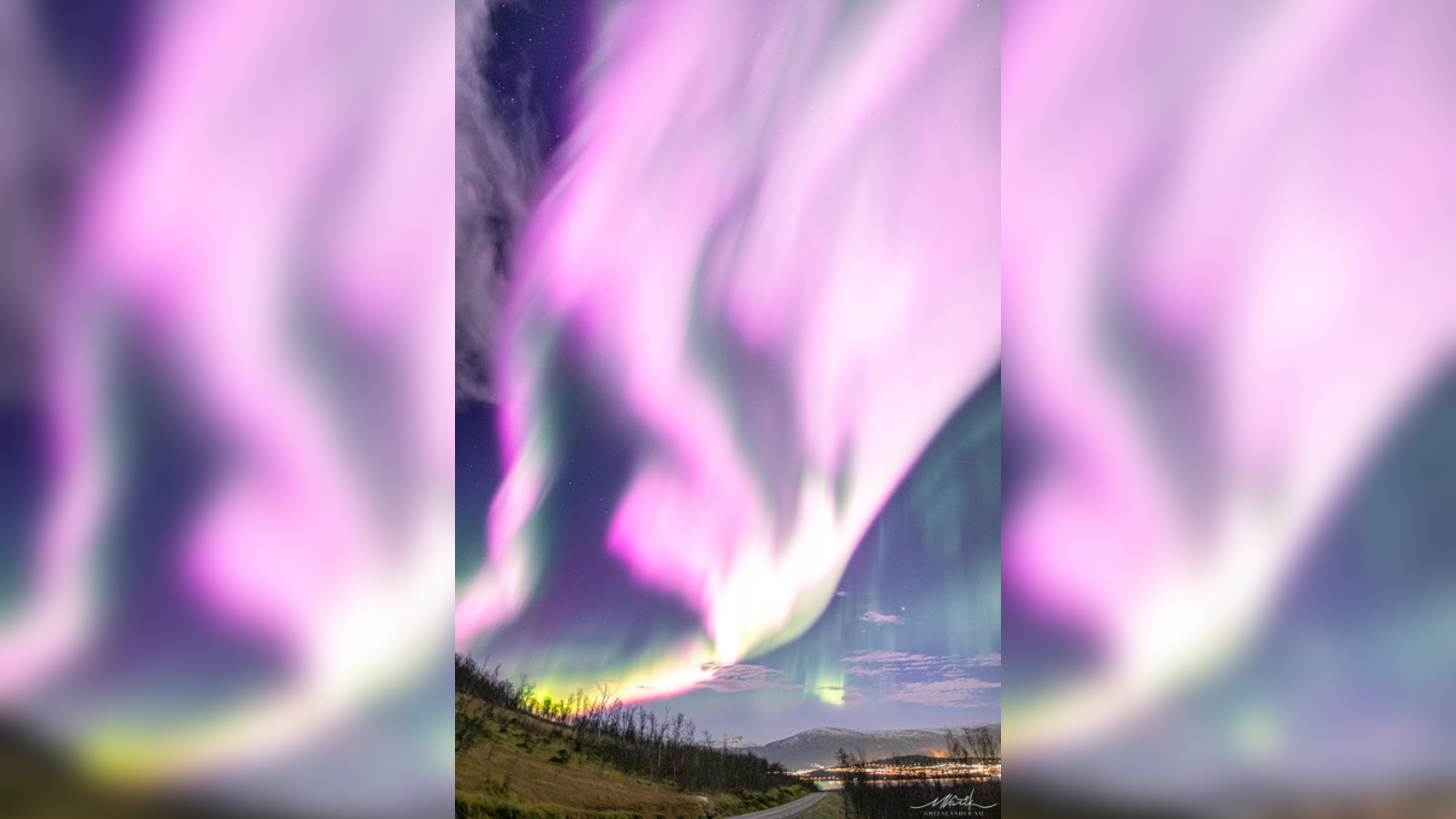
Solar storm smashes hole in Earth's magnetosphere, triggering extremely rare pink auroras
On Nov. 3, a solar storm caused a temporary crack in Earth's magnetic field. The resulting hole enabled energetic particles to penetrate deep into the planet's atmosphere and set off extremely rare pink auroras.
CrazyDiamond
HAL is a StarChild
By the way, in my previous post, that is not my twitter account....on to the good stuff!
When does a nebula look like a comet? In this crowded starfield, covering over two degrees within the high flying constellation of the Swan (Cygnus), the eye is drawn to the Cocoon Nebula. A compact star forming region, the cosmic Cocoon punctuates a nebula bright in emission and reflection on the left, with a long trail of interstellar dust clouds to the right, making the entire complex appear a bit like a comet. Cataloged as IC 5146, the central bright head of the nebula spans about 10 light years, while the dark dusty tail spans nearly 100 light years. Both are located about 2,500 light years away. The bright star near the bright nebula's center, likely only a few hundred thousand years old, supplies power to the nebular glow as it helps clear out a cavity in the molecular cloud's star forming dust and gas. The long dusty filaments of the tail, although dark in this visible light image, are themselves hiding stars in the process of formation, stars that can be seen at infrared wavelengths.

Why is the Lobster Nebula forming some of the most massive stars known? No one is yet sure. Cataloged as NGC 6357, the Lobster Nebula houses the open star cluster Pismis 24 near its center -- a home to unusually bright and massive stars. The overall red glow near the inner star forming region results from the emission of ionized hydrogen gas. The surrounding nebula, featured here, holds a complex tapestry of gas, dark dust, stars still forming, and newly born stars. The intricate patterns are caused by complex interactions between interstellar winds, radiation pressures, magnetic fields, and gravity. The image was taken with DOE's Dark Energy Camera on the 4-meter Blanco Telescope at the Cerro Tololo Inter-American Observatory in Chile. NGC 6357 spans about 400 light years and lies about 8,000 light years away toward the constellation of the Scorpion.
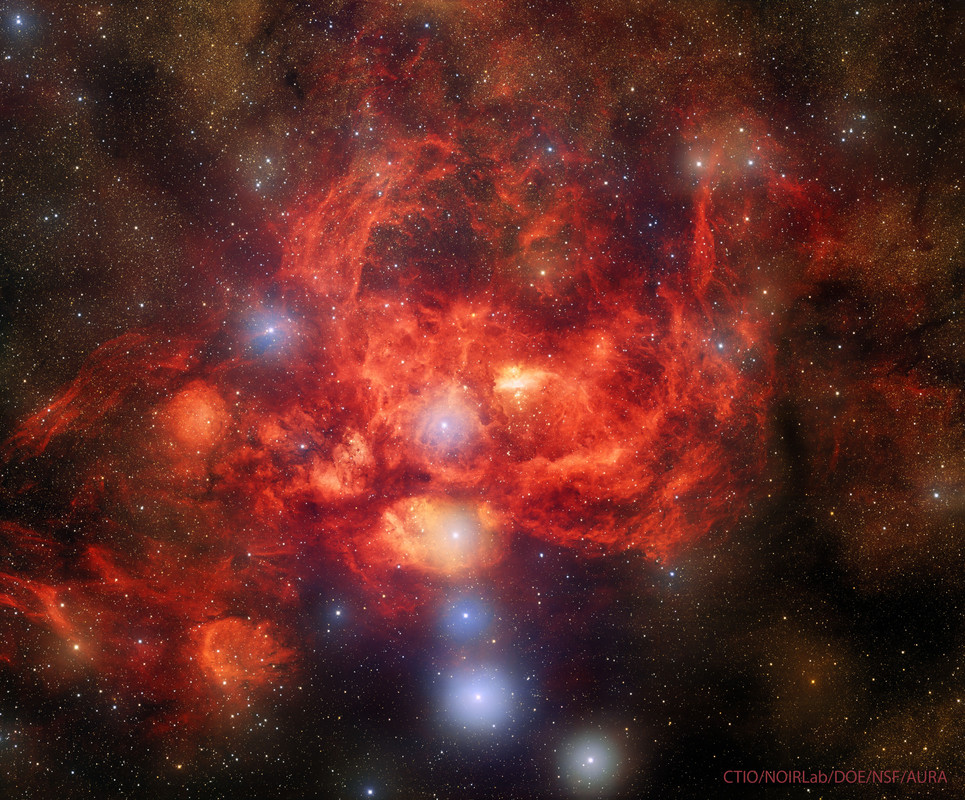
The small, northern constellation Triangulum harbors this magnificent face-on spiral galaxy, M33. Its popular names include the Pinwheel Galaxy or just the Triangulum Galaxy. M33 is over 50,000 light-years in diameter, third largest in the Local Group of galaxies after the Andromeda Galaxy (M31), and our own Milky Way. About 3 million light-years from the Milky Way, M33 is itself thought to be a satellite of the Andromeda Galaxy and astronomers in these two galaxies would likely have spectacular views of each other's grand spiral star systems. As for the view from the Milky Way, this sharp image combines data from telescopes on and around planet Earth to show off M33's blue star clusters and pinkish star forming regions along the galaxy's loosely wound spiral arms. In fact, the cavernous NGC 604 is the brightest star forming region, seen here at about the 1 o'clock position from the galaxy center. Like M31, M33's population of well-measured variable stars have helped make this nearby spiral a cosmic yardstick for establishing the distance scale of the Universe.
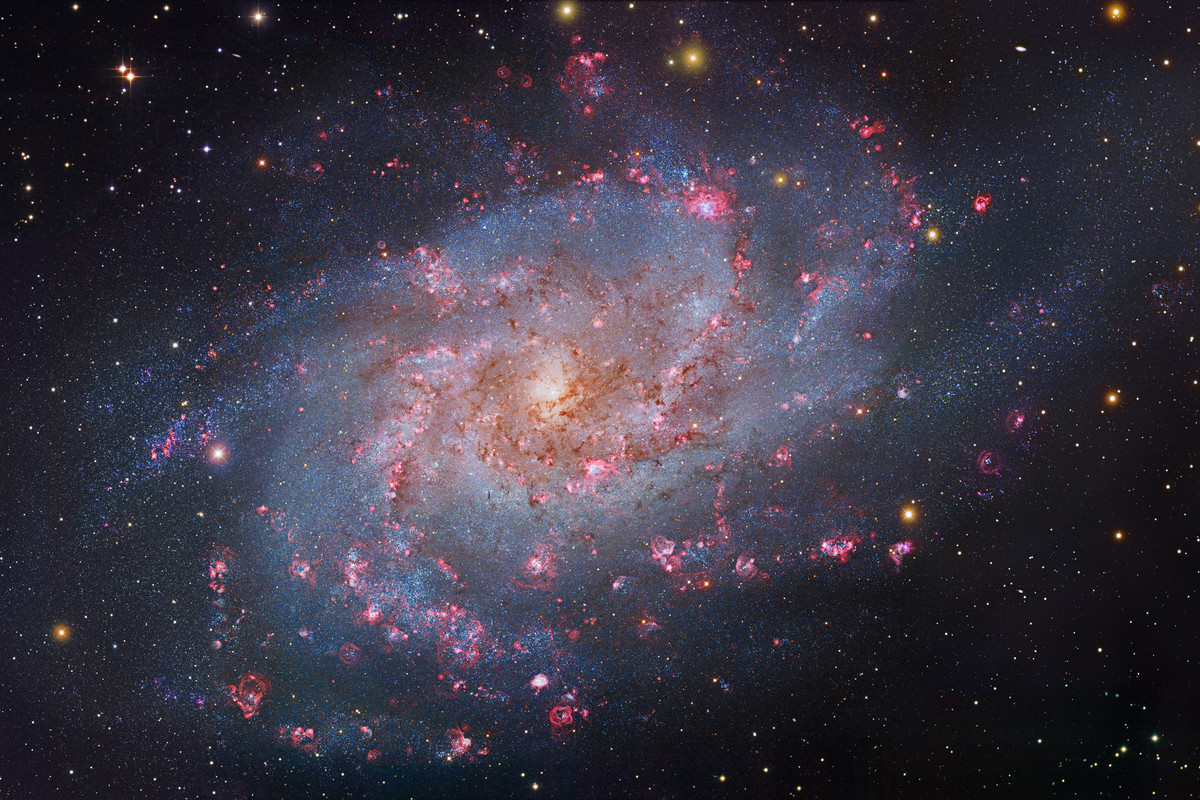
How many galaxies are interacting here? This grouping of galaxies is called the Wild Triplet, not only for the discoverer, but for the number of bright galaxies that appear. It had been assumed that all three galaxies, collectively cataloged as Arp 248, are interacting, but more recent investigations reveal that only the brightest two galaxies are sparring gravitationally: the big galaxies at the top and bottom. The spiral galaxy in the middle of the featured image by the Hubble Space Telescope is actually far in the distance, as is the galaxy just below it and all of the other numerous galaxies in the field. A striking result of these giants jousting is a tremendous bridge of stars, gas, and dust that stretches between them -- a bridge almost 200,000 light-years long. Light we see today from Wild's Triplet left about 200 million years ago, when dinosaurs roamed the Earth. In perhaps a billion years or so, the two interacting galaxies will merge to form a single large spiral galaxy.

NGC 3603 (left) and NGC 3576 (right) are two stunning nebulas imaged with ESO’s Visible and Infrared Survey Telescope for Astronomy (VISTA). This infrared image peers through the dust in these nebulas, revealing details hidden in optical images.
NGC 3603 and NGC 3576 are 22,000 and 9,000 lightyears away from us, respectively. Inside these extended clouds of dust and gas, new stars are born, gradually changing the shapes of the nebulas via intense radiation and powerful winds of charged particles. Given their proximity, astronomers have the opportunity to study the intense star formation process that is as common in other galaxies but harder to observe due to the vast distances.
The two nebulas were catalogued by John Frederick William Herschel in 1834 during a trip to South Africa, where he wanted to compile stars, nebulas and other objects in the sky of the southern hemisphere. This catalogue was then expanded by John Louis Emil Dreyer in 1888 into the New General Catalogue, hence the NGC identifier in these and other astronomical objects.
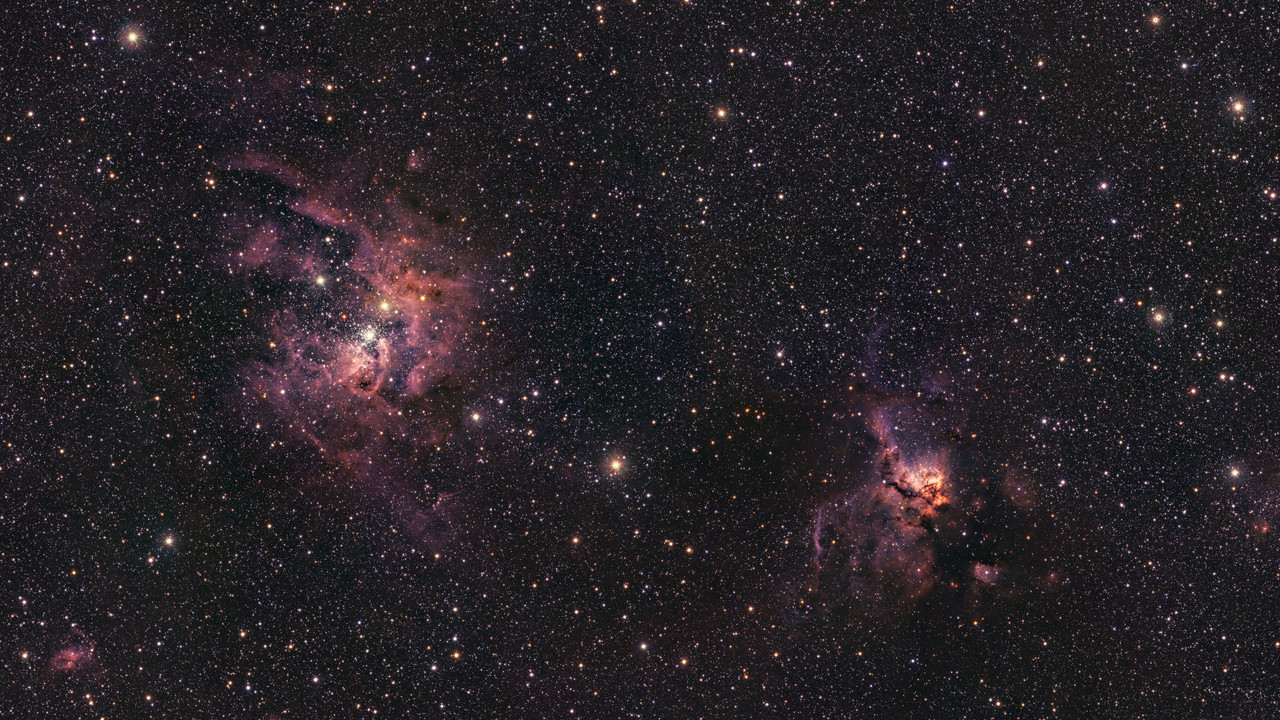
This image shows a spectacular view of the orange and pink clouds that make up what remains after the explosive death of a massive star — the Vela supernova remnant. This detailed image consists of 554 million pixels, and is a combined mosaic image of observations taken with the 268-million-pixel OmegaCAM camera at the VLT Survey Telescope, hosted at ESO’s Paranal Observatory.
OmegaCAM can take images through several filters that each let the telescope see the light emitted in a distinct color. To capture this image, four filters have been used, represented here by a combination of magenta, blue, green and red. The result is an extremely detailed and stunning view of both the gaseous filaments in the remnant and the foreground bright blue stars that add sparkle to the image.

When does a nebula look like a comet? In this crowded starfield, covering over two degrees within the high flying constellation of the Swan (Cygnus), the eye is drawn to the Cocoon Nebula. A compact star forming region, the cosmic Cocoon punctuates a nebula bright in emission and reflection on the left, with a long trail of interstellar dust clouds to the right, making the entire complex appear a bit like a comet. Cataloged as IC 5146, the central bright head of the nebula spans about 10 light years, while the dark dusty tail spans nearly 100 light years. Both are located about 2,500 light years away. The bright star near the bright nebula's center, likely only a few hundred thousand years old, supplies power to the nebular glow as it helps clear out a cavity in the molecular cloud's star forming dust and gas. The long dusty filaments of the tail, although dark in this visible light image, are themselves hiding stars in the process of formation, stars that can be seen at infrared wavelengths.

Why is the Lobster Nebula forming some of the most massive stars known? No one is yet sure. Cataloged as NGC 6357, the Lobster Nebula houses the open star cluster Pismis 24 near its center -- a home to unusually bright and massive stars. The overall red glow near the inner star forming region results from the emission of ionized hydrogen gas. The surrounding nebula, featured here, holds a complex tapestry of gas, dark dust, stars still forming, and newly born stars. The intricate patterns are caused by complex interactions between interstellar winds, radiation pressures, magnetic fields, and gravity. The image was taken with DOE's Dark Energy Camera on the 4-meter Blanco Telescope at the Cerro Tololo Inter-American Observatory in Chile. NGC 6357 spans about 400 light years and lies about 8,000 light years away toward the constellation of the Scorpion.

The small, northern constellation Triangulum harbors this magnificent face-on spiral galaxy, M33. Its popular names include the Pinwheel Galaxy or just the Triangulum Galaxy. M33 is over 50,000 light-years in diameter, third largest in the Local Group of galaxies after the Andromeda Galaxy (M31), and our own Milky Way. About 3 million light-years from the Milky Way, M33 is itself thought to be a satellite of the Andromeda Galaxy and astronomers in these two galaxies would likely have spectacular views of each other's grand spiral star systems. As for the view from the Milky Way, this sharp image combines data from telescopes on and around planet Earth to show off M33's blue star clusters and pinkish star forming regions along the galaxy's loosely wound spiral arms. In fact, the cavernous NGC 604 is the brightest star forming region, seen here at about the 1 o'clock position from the galaxy center. Like M31, M33's population of well-measured variable stars have helped make this nearby spiral a cosmic yardstick for establishing the distance scale of the Universe.

How many galaxies are interacting here? This grouping of galaxies is called the Wild Triplet, not only for the discoverer, but for the number of bright galaxies that appear. It had been assumed that all three galaxies, collectively cataloged as Arp 248, are interacting, but more recent investigations reveal that only the brightest two galaxies are sparring gravitationally: the big galaxies at the top and bottom. The spiral galaxy in the middle of the featured image by the Hubble Space Telescope is actually far in the distance, as is the galaxy just below it and all of the other numerous galaxies in the field. A striking result of these giants jousting is a tremendous bridge of stars, gas, and dust that stretches between them -- a bridge almost 200,000 light-years long. Light we see today from Wild's Triplet left about 200 million years ago, when dinosaurs roamed the Earth. In perhaps a billion years or so, the two interacting galaxies will merge to form a single large spiral galaxy.

NGC 3603 (left) and NGC 3576 (right) are two stunning nebulas imaged with ESO’s Visible and Infrared Survey Telescope for Astronomy (VISTA). This infrared image peers through the dust in these nebulas, revealing details hidden in optical images.
NGC 3603 and NGC 3576 are 22,000 and 9,000 lightyears away from us, respectively. Inside these extended clouds of dust and gas, new stars are born, gradually changing the shapes of the nebulas via intense radiation and powerful winds of charged particles. Given their proximity, astronomers have the opportunity to study the intense star formation process that is as common in other galaxies but harder to observe due to the vast distances.
The two nebulas were catalogued by John Frederick William Herschel in 1834 during a trip to South Africa, where he wanted to compile stars, nebulas and other objects in the sky of the southern hemisphere. This catalogue was then expanded by John Louis Emil Dreyer in 1888 into the New General Catalogue, hence the NGC identifier in these and other astronomical objects.

This image shows a spectacular view of the orange and pink clouds that make up what remains after the explosive death of a massive star — the Vela supernova remnant. This detailed image consists of 554 million pixels, and is a combined mosaic image of observations taken with the 268-million-pixel OmegaCAM camera at the VLT Survey Telescope, hosted at ESO’s Paranal Observatory.
OmegaCAM can take images through several filters that each let the telescope see the light emitted in a distinct color. To capture this image, four filters have been used, represented here by a combination of magenta, blue, green and red. The result is an extremely detailed and stunning view of both the gaseous filaments in the remnant and the foreground bright blue stars that add sparkle to the image.

Jill NYC
Portable Hoarder
Okla68
Well-Known Member
And if you look close you can see Blagg Crater. Discovered by a distant relative.
Order from Chaos — Blagg Crater
Blagg crater, named for the British astronomer who helped bring order to lunar naming chaos, is full of surprises. Taken during morning with the Sun shining from the right (east), the image above shows an area of the Moon just 9.5 kilometers wide. LROC NAC image pair M192946338LR...
CrazyDiamond
HAL is a StarChild
A couple new JWST images...
Hidden in the neck of this “hourglass” of light are the very beginnings of a new star — a protostar. The clouds of dust and gas within this region are only visible in infrared light, the wavelengths that Webb specializes in.
This protostar is a hot, puffy clump of gas that’s only a fraction of the mass of our Sun. As it draws material in, its core will compress, get hotter, and eventually begin nuclear fusion — creating a star!
See that dark line at the very center of the “hourglass”? That’s an edge-on view of a protoplanetary disk, or the disk of material being pulled into the star as it forms. It’s about the size of our solar system and may eventually clump into planets, giving us a window into our solar system’s history.
Light from the protostar is illuminating cavities in the dust and gas above and below its disk. (Think of flashlights pointing in opposite directions, each shining a cone of light.) The blue areas are where dust is thinnest, while orange represents thicker layers of dust.
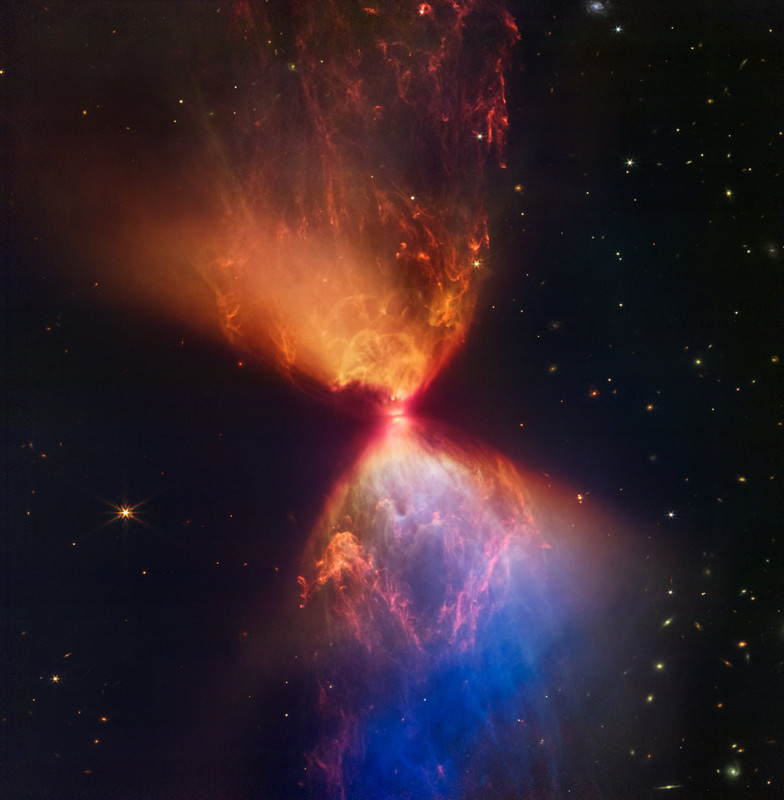
Dwarf galaxy Wolf-Lundmark-Melotte as viewed by the Webb telescope’s NIRCam instrument. Countless white stars, interspersed with yellow and orange background galaxies of various shapes, dot the black background. One prominent galaxy is a pale yellow spiral in the top left corner of the image. Another defining feature is a large white star with long diffraction spikes, seen just to the right of the top center.
In this brand new image of dwarf galaxy Wolf-Lundmark-Melotte (WLM), the Webb telescope demonstrates its remarkable ability to resolve faint stars outside the Milky Way.
Just 3 million light-years from Earth, WLM is considered a dwarf galaxy in our galactic neighborhood. While it is close, it’s much more isolated than other nearby galaxies, which interact with our own Milky Way. WLM also has a similar chemical makeup to galaxies in the early universe, meaning it’s poor in elements heavier than hydrogen and helium. Because WLM is small and low-mass, supernovae (star explosion) events can be powerful and energetic enough to expel heavier elements out of the galaxy.
Taken altogether, these traits make WLM ideal for studying how stars form and evolve in small galaxies, similar to those in the early universe. The science here is complementary to what we learn by looking at the farthest and oldest galaxies, which appear as they were when they first formed.
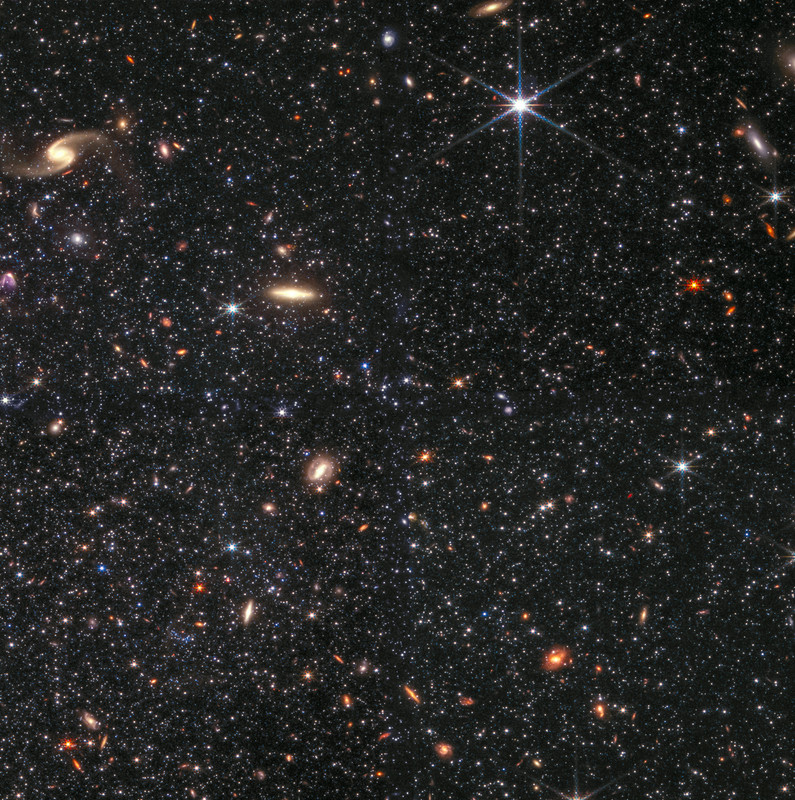
Hidden in the neck of this “hourglass” of light are the very beginnings of a new star — a protostar. The clouds of dust and gas within this region are only visible in infrared light, the wavelengths that Webb specializes in.
This protostar is a hot, puffy clump of gas that’s only a fraction of the mass of our Sun. As it draws material in, its core will compress, get hotter, and eventually begin nuclear fusion — creating a star!
See that dark line at the very center of the “hourglass”? That’s an edge-on view of a protoplanetary disk, or the disk of material being pulled into the star as it forms. It’s about the size of our solar system and may eventually clump into planets, giving us a window into our solar system’s history.
Light from the protostar is illuminating cavities in the dust and gas above and below its disk. (Think of flashlights pointing in opposite directions, each shining a cone of light.) The blue areas are where dust is thinnest, while orange represents thicker layers of dust.

Dwarf galaxy Wolf-Lundmark-Melotte as viewed by the Webb telescope’s NIRCam instrument. Countless white stars, interspersed with yellow and orange background galaxies of various shapes, dot the black background. One prominent galaxy is a pale yellow spiral in the top left corner of the image. Another defining feature is a large white star with long diffraction spikes, seen just to the right of the top center.
In this brand new image of dwarf galaxy Wolf-Lundmark-Melotte (WLM), the Webb telescope demonstrates its remarkable ability to resolve faint stars outside the Milky Way.
Just 3 million light-years from Earth, WLM is considered a dwarf galaxy in our galactic neighborhood. While it is close, it’s much more isolated than other nearby galaxies, which interact with our own Milky Way. WLM also has a similar chemical makeup to galaxies in the early universe, meaning it’s poor in elements heavier than hydrogen and helium. Because WLM is small and low-mass, supernovae (star explosion) events can be powerful and energetic enough to expel heavier elements out of the galaxy.
Taken altogether, these traits make WLM ideal for studying how stars form and evolve in small galaxies, similar to those in the early universe. The science here is complementary to what we learn by looking at the farthest and oldest galaxies, which appear as they were when they first formed.

CrazyDiamond
HAL is a StarChild
Was wondering what happened to you, lol, that happens to me all the time with other threads.
cybrguy
Putin is a War Criminal
cybrguy
Putin is a War Criminal
How beautiful...
cybrguy
Putin is a War Criminal
Orion should be splashing down in about 7 minutes...

 www.nasa.gov
www.nasa.gov

Live Coverage of NASA's Artemis I Mission to the Moon
NASA.gov brings you the latest images, videos and news from America's space agency. Get the latest updates on NASA missions, watch NASA TV live, and learn about our quest to reveal the unknown and benefit all humankind.
CrazyDiamond
HAL is a StarChild
The mysterious blue reflection nebula found in catalogs as VdB 152 or Ced 201 really is very faint. It lies at the tip of the long dark nebula Barnard 175 in a dusty complex that has also been called Wolf's Cave. At the center of this deep telescopic view, the cosmic apparitions are nearly 1,400 light-years away along the northern Milky Way in the royal constellation Cepheus. Interstellar dust in the region blocks light from background stars and scatters light from the embedded bright star, giving the end nebula its characteristic blue color. Though stars do form in molecular clouds, this star seems to have only accidentally wandered into the area, as its measured velocity through space is very different from the cloud's velocity. At the image bottom is the planetary nebula Dengel-Hartl 5, while red glowing gas from an ancient supernova remnant is also visible along the image's right side.
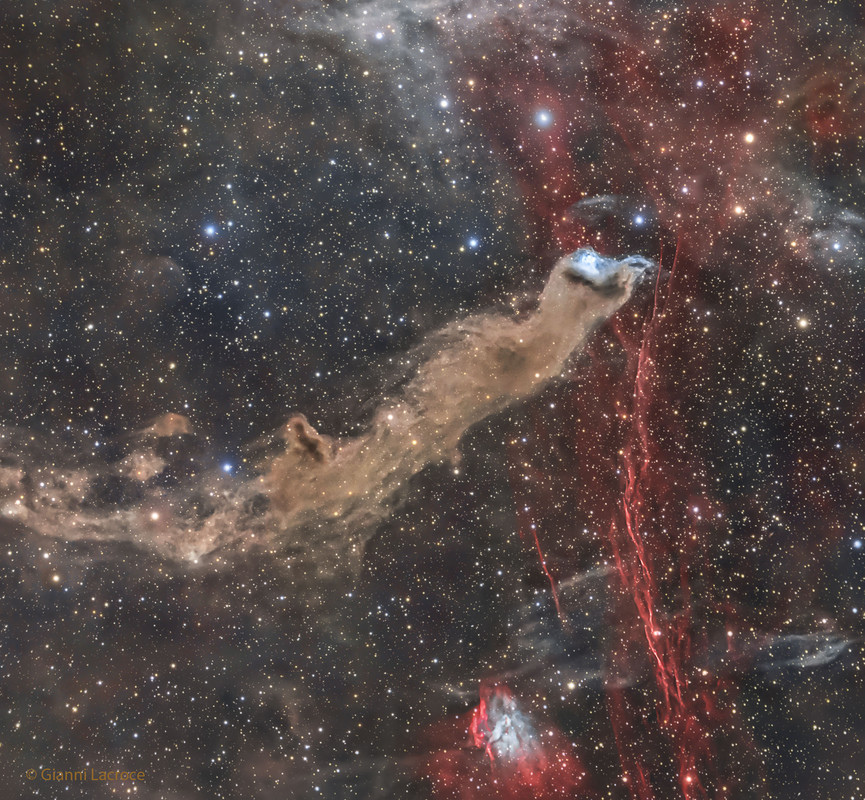
Stars can make beautiful patterns as they age -- sometimes similar to flowers or insects. NGC 6302, the Butterfly Nebula, is a notable example. Though its gaseous wingspan covers over 3 light-years and its estimated surface temperature exceeds 200,000 degrees C, the aging central star of NGC 6302, the featured planetary nebula, has become exceptionally hot, shining brightly in visible and ultraviolet light but hidden from direct view by a dense torus of dust. This sharp close-up was recorded by the Hubble Space Telescope and is processed here to show off remarkable details of the complex planetary nebula, highlighting in particular light emitted by oxygen (shown as blue), hydrogen (green), and nitrogen (red). NGC 6302 lies about 3,500 light-years away in the arachnologically correct constellation of the Scorpion (Scorpius). Planetary nebulas evolve from outer atmospheres of stars like our Sun, but usually fade in about 20,000 years.

Few star clusters are this close to each other. Visible to the unaided eye from dark sky areas, it was cataloged in 130 BC by Greek astronomer Hipparchus. Some 7,000 light-years away, this pair of open star clusters is also an easy binocular target, a striking starfield in the northern constellation of the mythical Greek hero Perseus. Now known as h and chi Persei, or NGC 869 (above right) and NGC 884, the clusters themselves are separated by only a few hundred light-years and contain stars much younger and hotter than the Sun. In addition to being physically close together, the clusters' ages based on their individual stars are similar - evidence that both clusters were likely a product of the same star-forming region.
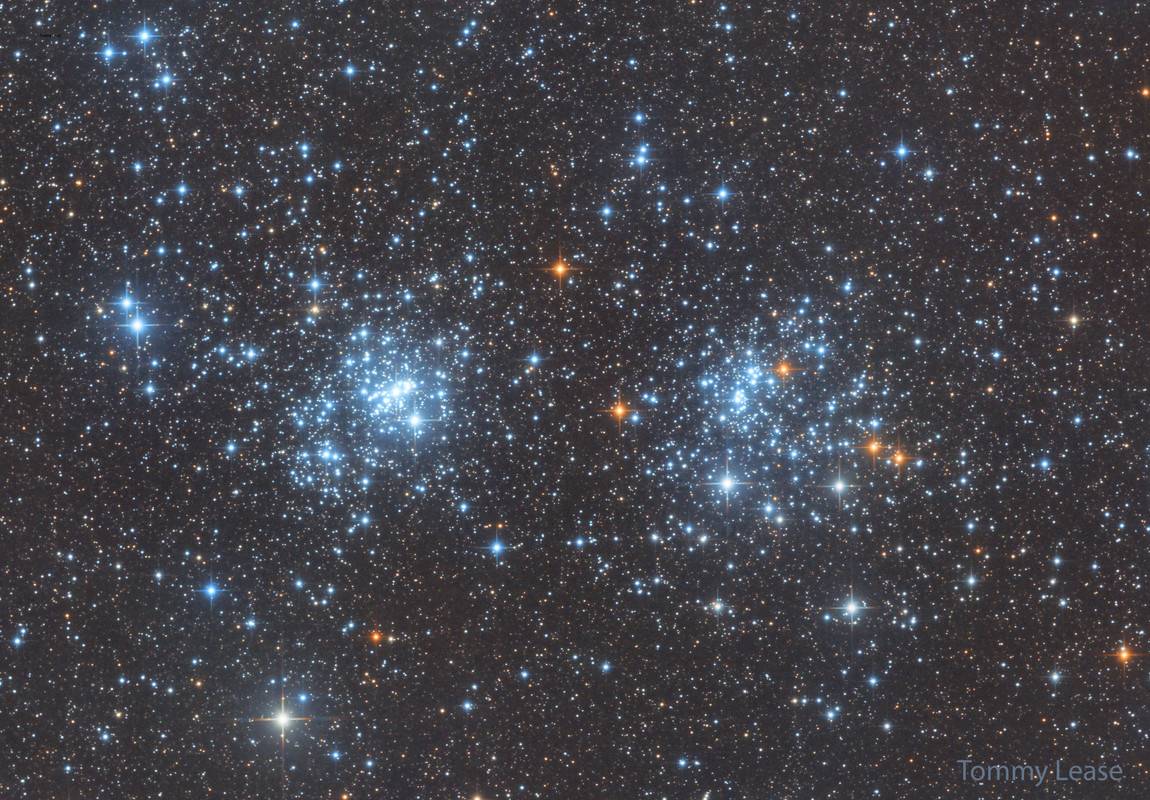
This colorful skyscape spans about four full moons across nebula rich starfields along the plane of our Milky Way Galaxy in the royal northern constellation Cepheus. Near the edge of the region's massive molecular cloud some 2,400 light-years away, bright reddish emission region Sharpless (Sh) 155 is at the center of the frame, also known as the Cave Nebula. About 10 light-years across the cosmic cave's bright walls of gas are ionized by ultraviolet light from the hot young stars around it. Dusty reflection nebulae, like vdB 155 to the right, and dense obscuring clouds of dust also abound on the interstellar canvas. Astronomical explorations have revealed other dramatic signs of star formation, including the bright reddish fleck of Herbig-Haro (HH) 168. Below and right of center, the Herbig-Haro object emission is generated by energetic jets from a newborn star.
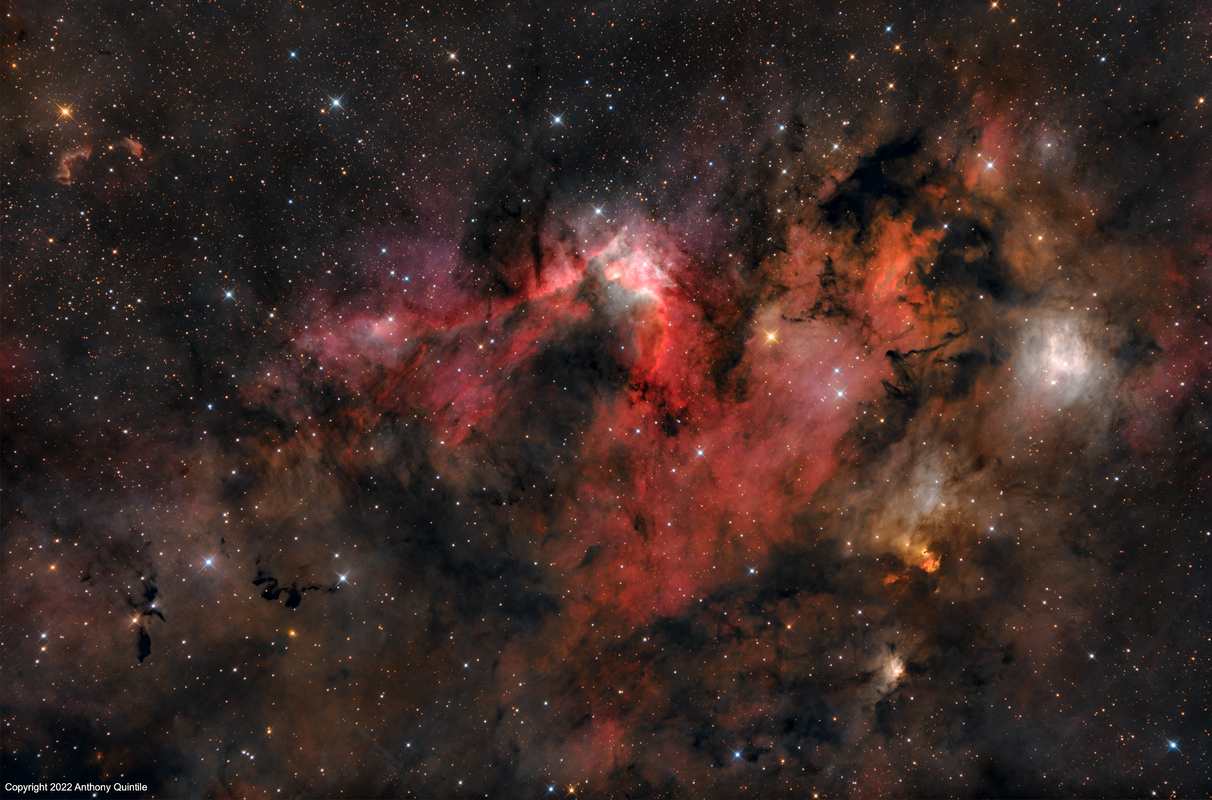
Bright at infrared wavelengths, this merging galaxy pair is some 500 million light-years away toward the constellation Delphinus. The cosmic mashup is seen against a background of even more distant galaxies, and occasional spiky foreground stars. But the galaxy merger itself spans about 100,000 light-years in this deep James Webb Space Telescope image. The image data is from Webb's Near-InfraRed Camera (NIRCam) and Mid-InfraRed Instrument (MIRI). Their combined, sharp infrared view follows galactic scale restructuring in the dusty merger's wild jumble of intense star forming regions and distorted spiral arms
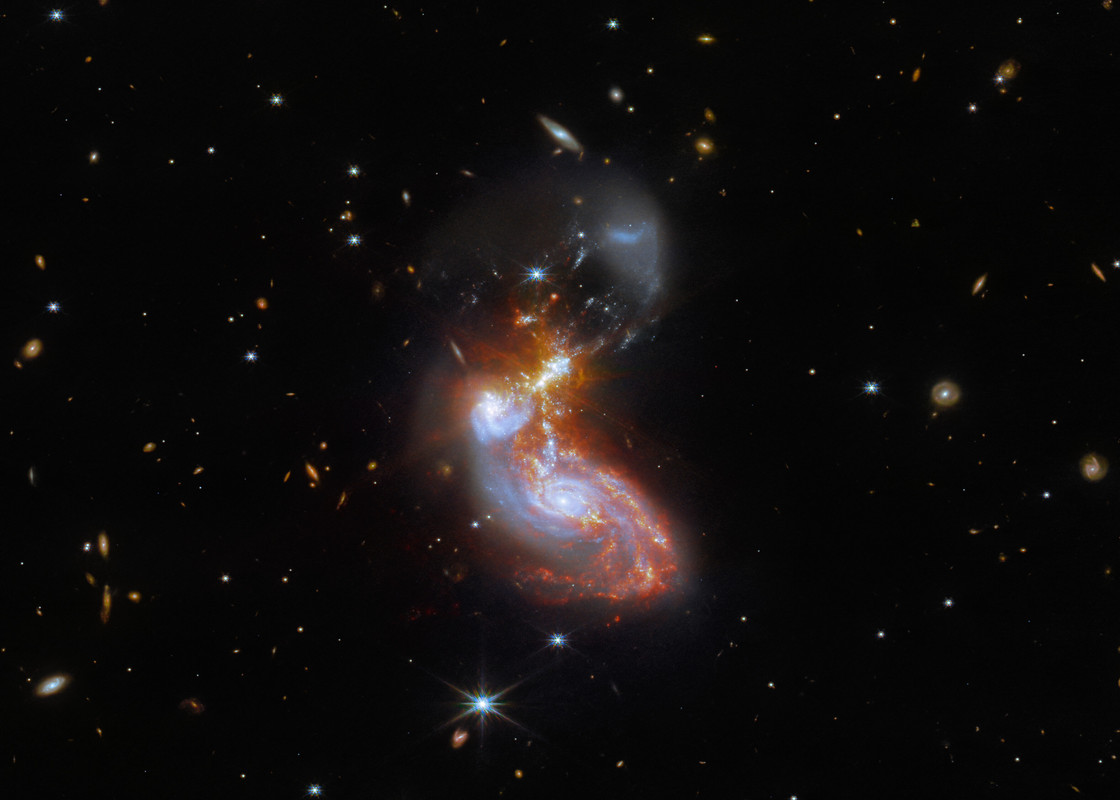
The Moon was at last quarter for the November 16 launch and near the horizon in the dark early hours after midnight. It's captured here in skies over Kennedy Space Center along with the SLS rocket engines and solid rocket boosters lofting the uncrewed Orion to space. Ragged fringes appearing along the bright edge of the sunlit lunar nearside are caused as pressure waves generated by the rocket's passage change the index of refraction along the camera's line of sight.

I LOVE THIS IMAGE!
On flight day 13 (November 28) of the Artemis 1 mission the Orion spacecraft reached its maximum distance from Earth. In fact, over 430,000 kilometers from Earth its distant retrograde orbit also put Orion nearly 70,000 kilometers from the Moon. In the same field of view in this video frame from flight day 13, planet and large natural satellite even appear about the same apparent size from the uncrewed spacecraft's perspective. Today (December 1) should see Orion depart its distant retrograde orbit. En route to planet Earth it will head toward a second powered fly by of the Moon. Splashdown on the home world is expected on December 11.
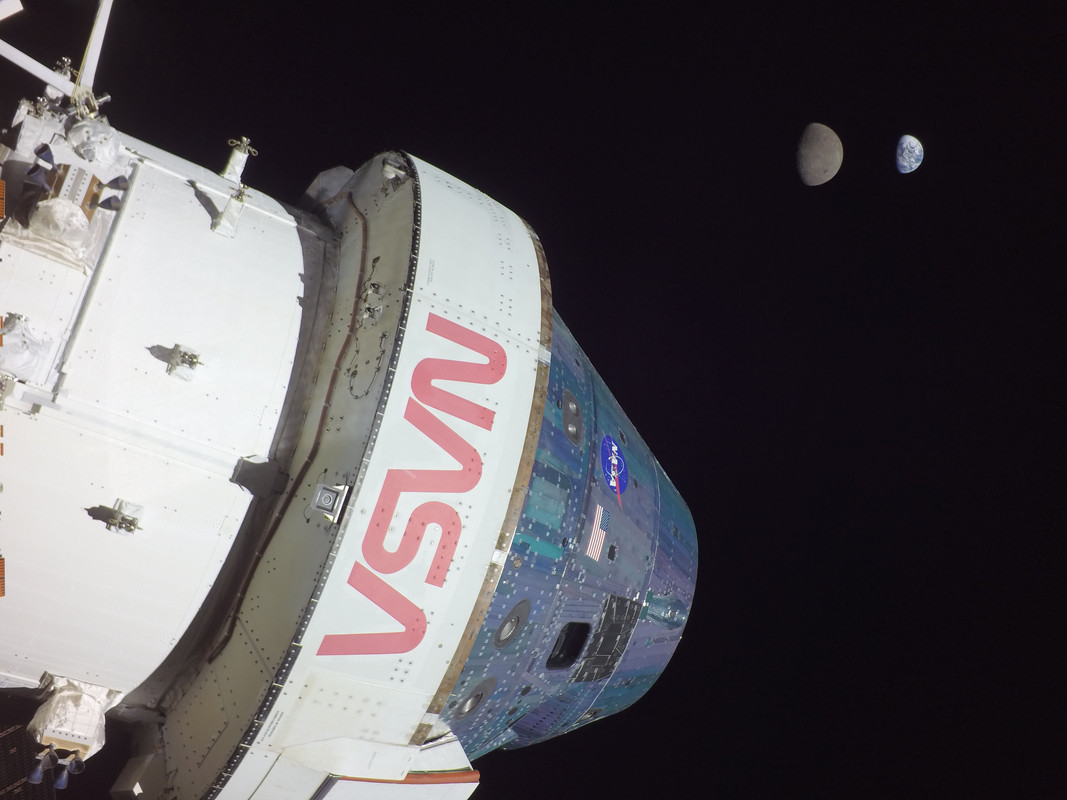

Stars can make beautiful patterns as they age -- sometimes similar to flowers or insects. NGC 6302, the Butterfly Nebula, is a notable example. Though its gaseous wingspan covers over 3 light-years and its estimated surface temperature exceeds 200,000 degrees C, the aging central star of NGC 6302, the featured planetary nebula, has become exceptionally hot, shining brightly in visible and ultraviolet light but hidden from direct view by a dense torus of dust. This sharp close-up was recorded by the Hubble Space Telescope and is processed here to show off remarkable details of the complex planetary nebula, highlighting in particular light emitted by oxygen (shown as blue), hydrogen (green), and nitrogen (red). NGC 6302 lies about 3,500 light-years away in the arachnologically correct constellation of the Scorpion (Scorpius). Planetary nebulas evolve from outer atmospheres of stars like our Sun, but usually fade in about 20,000 years.

Few star clusters are this close to each other. Visible to the unaided eye from dark sky areas, it was cataloged in 130 BC by Greek astronomer Hipparchus. Some 7,000 light-years away, this pair of open star clusters is also an easy binocular target, a striking starfield in the northern constellation of the mythical Greek hero Perseus. Now known as h and chi Persei, or NGC 869 (above right) and NGC 884, the clusters themselves are separated by only a few hundred light-years and contain stars much younger and hotter than the Sun. In addition to being physically close together, the clusters' ages based on their individual stars are similar - evidence that both clusters were likely a product of the same star-forming region.

This colorful skyscape spans about four full moons across nebula rich starfields along the plane of our Milky Way Galaxy in the royal northern constellation Cepheus. Near the edge of the region's massive molecular cloud some 2,400 light-years away, bright reddish emission region Sharpless (Sh) 155 is at the center of the frame, also known as the Cave Nebula. About 10 light-years across the cosmic cave's bright walls of gas are ionized by ultraviolet light from the hot young stars around it. Dusty reflection nebulae, like vdB 155 to the right, and dense obscuring clouds of dust also abound on the interstellar canvas. Astronomical explorations have revealed other dramatic signs of star formation, including the bright reddish fleck of Herbig-Haro (HH) 168. Below and right of center, the Herbig-Haro object emission is generated by energetic jets from a newborn star.

Bright at infrared wavelengths, this merging galaxy pair is some 500 million light-years away toward the constellation Delphinus. The cosmic mashup is seen against a background of even more distant galaxies, and occasional spiky foreground stars. But the galaxy merger itself spans about 100,000 light-years in this deep James Webb Space Telescope image. The image data is from Webb's Near-InfraRed Camera (NIRCam) and Mid-InfraRed Instrument (MIRI). Their combined, sharp infrared view follows galactic scale restructuring in the dusty merger's wild jumble of intense star forming regions and distorted spiral arms

The Moon was at last quarter for the November 16 launch and near the horizon in the dark early hours after midnight. It's captured here in skies over Kennedy Space Center along with the SLS rocket engines and solid rocket boosters lofting the uncrewed Orion to space. Ragged fringes appearing along the bright edge of the sunlit lunar nearside are caused as pressure waves generated by the rocket's passage change the index of refraction along the camera's line of sight.

I LOVE THIS IMAGE!
On flight day 13 (November 28) of the Artemis 1 mission the Orion spacecraft reached its maximum distance from Earth. In fact, over 430,000 kilometers from Earth its distant retrograde orbit also put Orion nearly 70,000 kilometers from the Moon. In the same field of view in this video frame from flight day 13, planet and large natural satellite even appear about the same apparent size from the uncrewed spacecraft's perspective. Today (December 1) should see Orion depart its distant retrograde orbit. En route to planet Earth it will head toward a second powered fly by of the Moon. Splashdown on the home world is expected on December 11.

Ramahs
Fucking Combustion (mostly) Since February 2017
Over 200 million Americans watched the total solar eclipse in August 2017, but no one had a better view than photographer Jon Carmichael. He spent years plotting how he could capture the total eclipse in a unique way.⠀
The image was created by shots photographer Jon Carmichael took while flying at 39,000 feet on a Southwest flight from Portland, Oregon, to St. Louis.
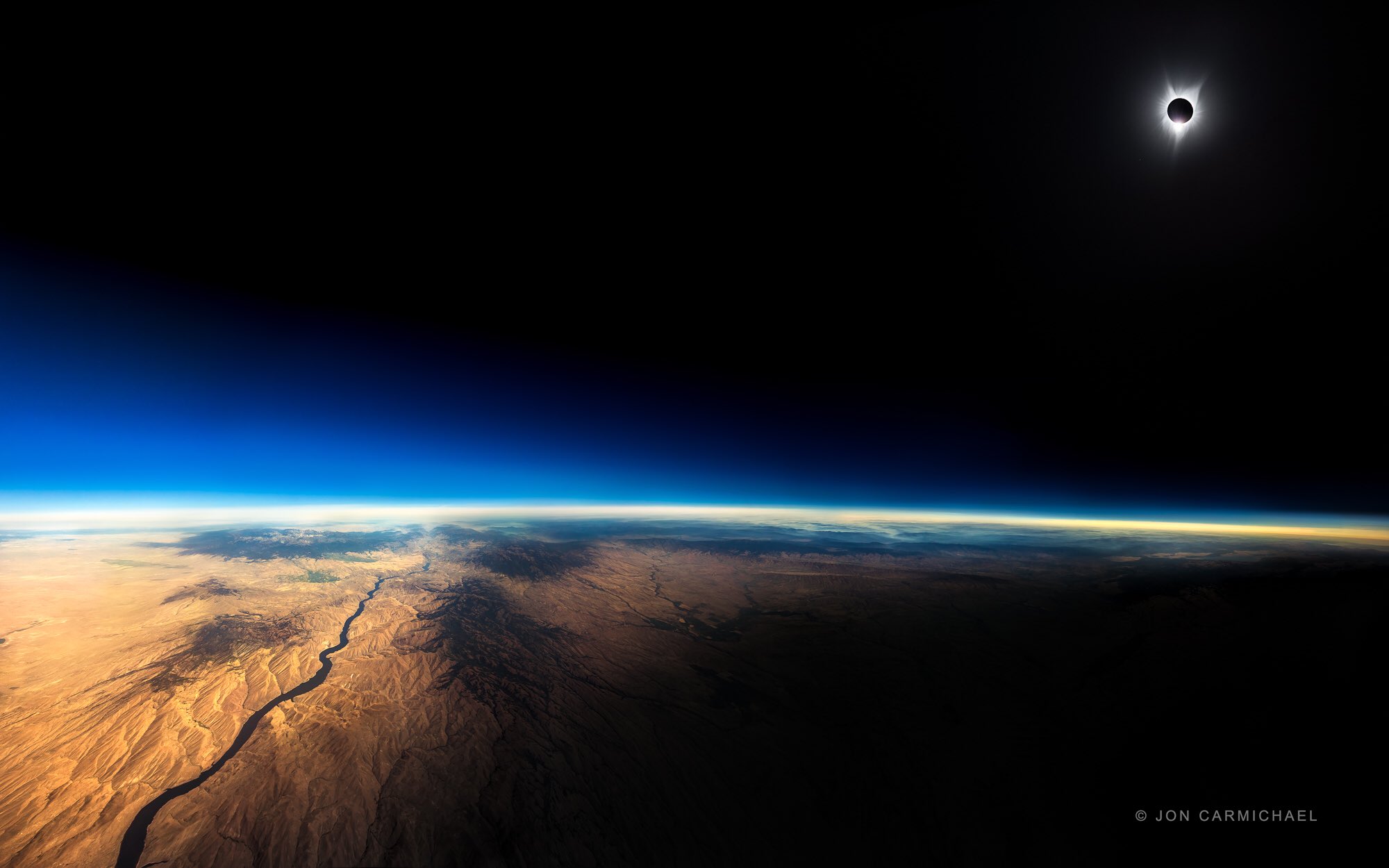
The image was created by shots photographer Jon Carmichael took while flying at 39,000 feet on a Southwest flight from Portland, Oregon, to St. Louis.


13 full moons, including 4 supermoons and a blue moon, will shine in 2023
Sky watchers will get an extra treat in 2023, with 13 full moons on tap, including four big “supermoons” and one “blue moon.” There’s also a partial solar eclipse coming in the new year, but that will have limited visibility in the eastern United States. A more significant solar eclipse will...
 www.rawstory.com
www.rawstory.com


